Companion Animal Management Exam 2
5.0(1)
Card Sorting
1/126
Earn XP
Description and Tags
Study Analytics
Name | Mastery | Learn | Test | Matching | Spaced |
|---|
No study sessions yet.
127 Terms
1
New cards
Ancestral Fish: Ostracoderms
- Fossil evidence indicates that fish developed about 425 to 500 million years ago.
- They are believed to be the oldest-known, ancestral fish group and the first animals with backbones.
1- The body was cylindrical or compressed dorso-ventrally.
2- They had poorly developed fins, mostly slow, and bottom-dwelling
3- Exoskeleton: the body covered with thick bony plates and scales.
4- Gills were exposed in the ventral aspect of the body.
5- They did not have jaws (the mouth is a sucker-like structure):
feeding is by the muscular pharynx to create a suction that pulled small and slow-moving prey into their mouths
- They are believed to be the oldest-known, ancestral fish group and the first animals with backbones.
1- The body was cylindrical or compressed dorso-ventrally.
2- They had poorly developed fins, mostly slow, and bottom-dwelling
3- Exoskeleton: the body covered with thick bony plates and scales.
4- Gills were exposed in the ventral aspect of the body.
5- They did not have jaws (the mouth is a sucker-like structure):
feeding is by the muscular pharynx to create a suction that pulled small and slow-moving prey into their mouths
2
New cards
The only modern fish still resembles old fish is
Hagfish; Eel-shaped, slime-producing marine fish.
- They are the only known living animals that have a skull but no
vertebral column (remaining parts of the exoskeleton).
- They are jawless: living hagfish remain similar to hagfish from
around 300 million years ago
- They are the only known living animals that have a skull but no
vertebral column (remaining parts of the exoskeleton).
- They are jawless: living hagfish remain similar to hagfish from
around 300 million years ago
3
New cards
Scales
Scales in fish are ranging from – very rigid body armor plates such as in shrimp or boxfish to microscopic or even absent such as in eels. Colored or reflect body coloration, deeply attached to the dermis.
4
New cards
The morphology of a scale in fish can be used to identify ...
the species or the order that they belong to.
5
New cards
Placoid (scale type)
(sharp scale with pointed backward projection) found on sharks and rays
6
New cards
Cosmoid (scale type)
A very hard outer layer withstand dehydration- found on lungfishes
7
New cards
Ganoid (scale type)
Hard outer layer with shiny surface found on Bowfin fish
8
New cards
Cycloid (smooth) and Ctenoid (serrated edge) (scale type)
are found in the majority of bony fishes. The anterior part of each scale is usually overlapped by the posterior portion of the scale in front. Most aquarium fish.
9
New cards
Common age determination with fish ...
- The most common age determination method is by counting rings on the fish scale; each ring indicates a growth phase which might be a season or a year depending on the type and habitat of the fish.
- Scales show rings that indicate periods of growth, rings that are farther apart occur when the fish grows well and there are lots of food – for example in the summer season.
- Rings that are close together occur when the fish does not get much food and grows slowly.
- On the scale, you can identify the summer growth and the winter growth.
(There will be several rings in each).
- Scales show rings that indicate periods of growth, rings that are farther apart occur when the fish grows well and there are lots of food – for example in the summer season.
- Rings that are close together occur when the fish does not get much food and grows slowly.
- On the scale, you can identify the summer growth and the winter growth.
(There will be several rings in each).
10
New cards
Slime gland
- Fish skin contains glands that produce a slimy mucus layer over the
fish body.
“ With either too much or too little of this slimy coat, any fish will soon die”?
1) Osmoregulation: Freshwater fish bodies are “saltier” than water and vice versa in marine fishes, so slime provides a selective interface to maintain internal/external ionic balance; by preventing extra water flow to the fish body.
2) External Protection:
- Body slime prevents attachment of ectoparasites by making the surface of the fish slippery, sloughing off with the parasite and suffocating pathogens.
- It also acts as a bandage by covering over a wound caused by trauma or infection.
3) Reduces Turbulence: Especially in fast-moving fishes.
4) Protect against predation and produce toxins; slime makes the fish slippery which help in escaping from predators.
- Also, some fish produce toxins in the slime layer which are able top immobilize other fishes when contacting them.
5) Alarm Substances: A lot of aquarium fishes such as Tetras and Catfishes produce alarm substances when they are under attack or when their skin is broken “fright signaling” that notifies others that something is going wrong. This substance is not species specific.
6) Nest Building Materials: In some species such as the Gouramis
and Bettas, slime is utilized in the construction of "Bubble Nests“.
fish body.
“ With either too much or too little of this slimy coat, any fish will soon die”?
1) Osmoregulation: Freshwater fish bodies are “saltier” than water and vice versa in marine fishes, so slime provides a selective interface to maintain internal/external ionic balance; by preventing extra water flow to the fish body.
2) External Protection:
- Body slime prevents attachment of ectoparasites by making the surface of the fish slippery, sloughing off with the parasite and suffocating pathogens.
- It also acts as a bandage by covering over a wound caused by trauma or infection.
3) Reduces Turbulence: Especially in fast-moving fishes.
4) Protect against predation and produce toxins; slime makes the fish slippery which help in escaping from predators.
- Also, some fish produce toxins in the slime layer which are able top immobilize other fishes when contacting them.
5) Alarm Substances: A lot of aquarium fishes such as Tetras and Catfishes produce alarm substances when they are under attack or when their skin is broken “fright signaling” that notifies others that something is going wrong. This substance is not species specific.
6) Nest Building Materials: In some species such as the Gouramis
and Bettas, slime is utilized in the construction of "Bubble Nests“.
11
New cards
Pigment cells
- The skin contains pigment cells (Chromatophores), which give fish their color – 3 types.
Melanophores – black, browns and blues
Xanthophores – red, yellow and orange
Iridophores – reflect light – produce silvery shine
- Most fish have coloration that allows them to blend into their environment, many fish are able to change their color if necessary.
Melanophores – black, browns and blues
Xanthophores – red, yellow and orange
Iridophores – reflect light – produce silvery shine
- Most fish have coloration that allows them to blend into their environment, many fish are able to change their color if necessary.
12
New cards
Lateral line: (!EARS!)
- Under these scales are a system of fluid-filled canals and specialized cells which transmit vibrations to the brain.
- The lateral line helps fish to detect objects including predators and prey.
- The lateral line helps fish to detect objects including predators and prey.
13
New cards
Body fins
- Most fish will have at least one dorsal fin on the back, a single anal fin and a single tail fin.
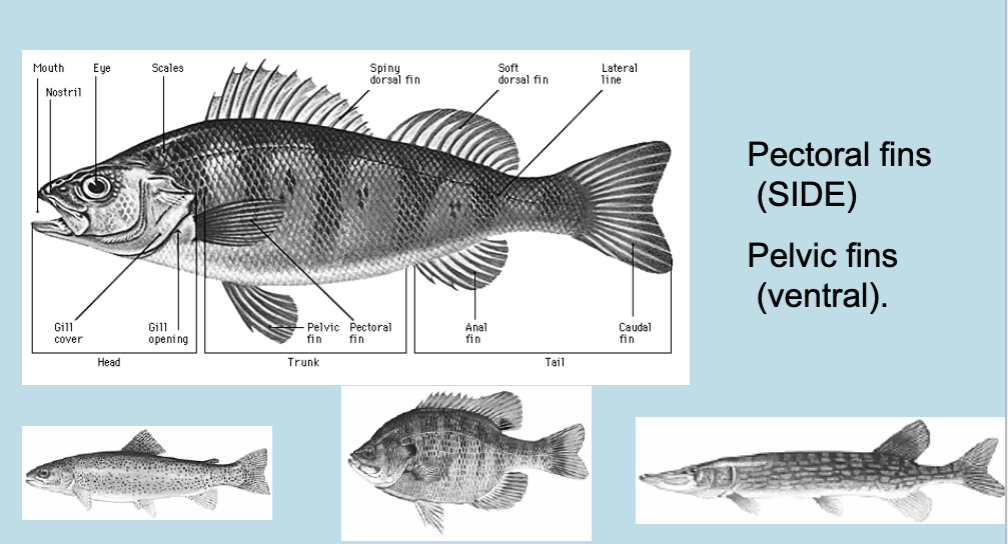
14
New cards
Respiration
- All fish breath through gills, usually 4 gills on each side of fish.
- Water is constantly drawn in through the mouth (constant opening and closing) passing through the gills and out the gill openings on the side of the fish.
- O2 dissolved in the water is taken into the blood and CO2 is released from the blood in the gills into the water.
- Water is constantly drawn in through the mouth (constant opening and closing) passing through the gills and out the gill openings on the side of the fish.
- O2 dissolved in the water is taken into the blood and CO2 is released from the blood in the gills into the water.
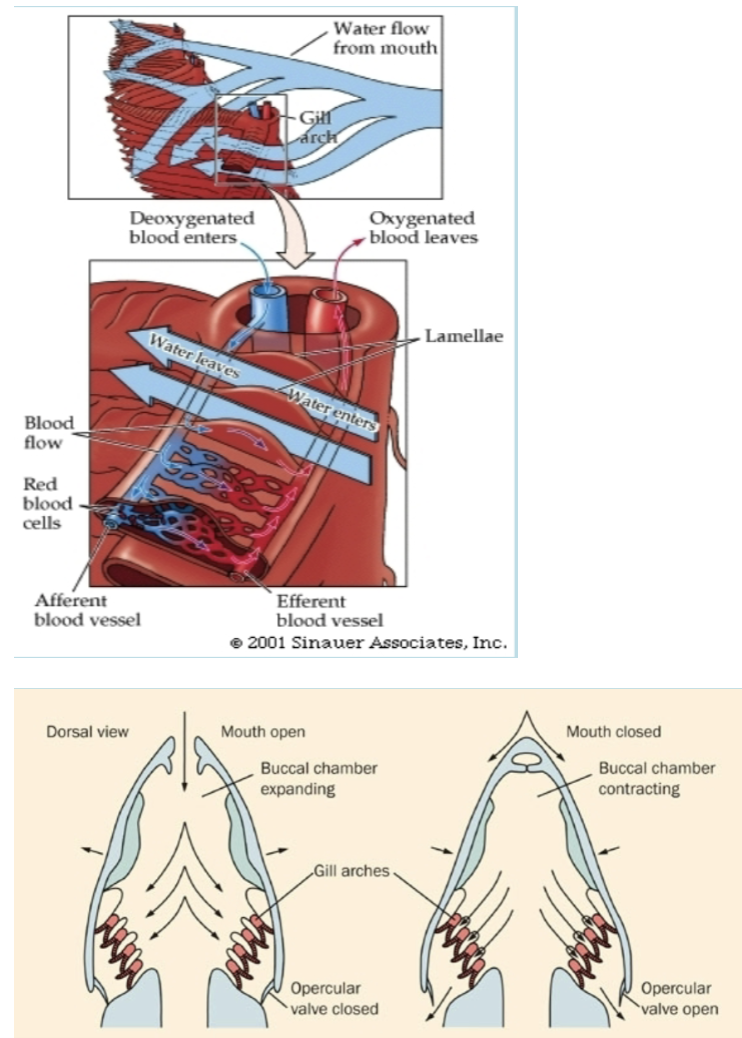
15
New cards
Swim Bladder
- Fills with gases from the blood and allows the fish to maintain a particular depth (buoyancy).
Trout – single; goldfish – 2 chambered; Angelfish – 3 chambered
- In a few species of fish, it may act like a lung – they can breathe atmospheric air (As an adaptation in fish that live in swamps and some waters that are poorly oxygenated).
Trout – single; goldfish – 2 chambered; Angelfish – 3 chambered
- In a few species of fish, it may act like a lung – they can breathe atmospheric air (As an adaptation in fish that live in swamps and some waters that are poorly oxygenated).
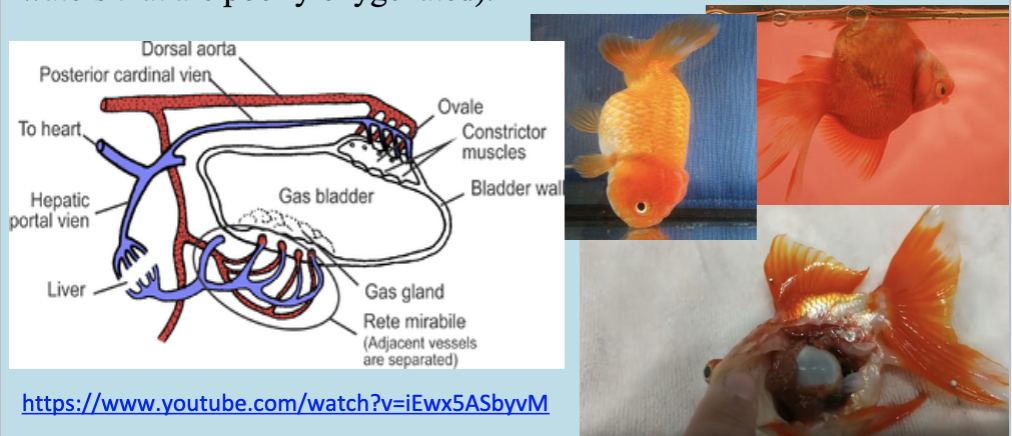
16
New cards
Blood circulation
- In most fishes, the heart is a single two-chambered pump. Deoxygenated blood is pumped forward from the ventricle to the gills where oxygen and carbon dioxide are exchanged.
- The oxygenated blood then passes to the tissues, where it loses oxygen, and eventually returns to the heart, which it enters through the single atrium.
- The oxygenated blood then passes to the tissues, where it loses oxygen, and eventually returns to the heart, which it enters through the single atrium.
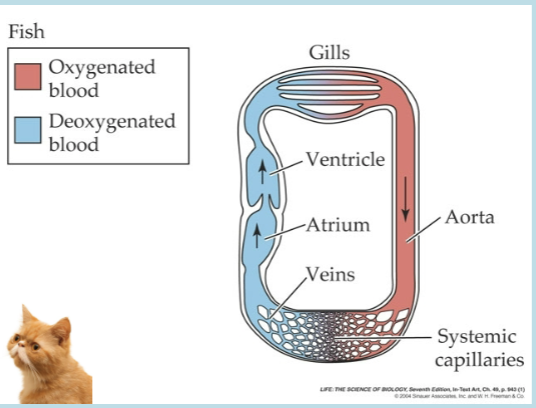
17
New cards
Eyes (fish)
- Spherical lens can not change curvature so focuses by moving in the eye.
- Fish have no eyelids.
- Size of the eye depends on amount of light it receives (Fish found in caves may have no or degenerated eyes)
- Different types of cone and rod cells.
- Fish have no eyelids.
- Size of the eye depends on amount of light it receives (Fish found in caves may have no or degenerated eyes)
- Different types of cone and rod cells.
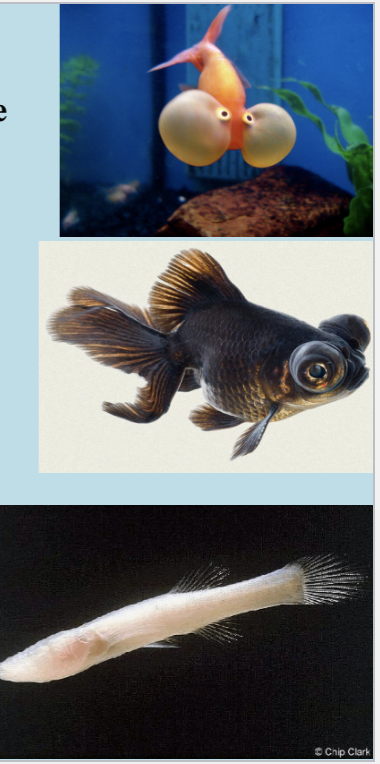
18
New cards
Taste Buds (fish)
- Fish have taste buds in their mouth, on their lips, tongue, and on their body and fins.
- Many fish will have barbell (whisker-like projections) around their mouth which will also have taste buds.
- Fish taste buds have the ability to distinguish the difference between sweet, sour, salty, and bitter >>>> some scientists said<<
- Many fish will have barbell (whisker-like projections) around their mouth which will also have taste buds.
- Fish taste buds have the ability to distinguish the difference between sweet, sour, salty, and bitter >>>> some scientists said<<
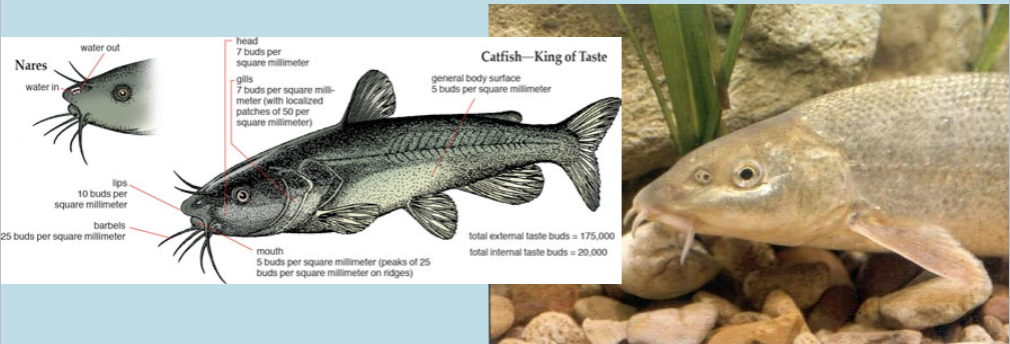
19
New cards
Egg layers (Oviparous) (fish)
- Egg layers can then be broken down into 5 different groups.
- All egg layers – (External fertilization) the eggs are fertilized after being laid.
- Sperm from the male is known as Milt.
- The behavior of expelling the eggs and fertilization by the male is known as spawning.
- All egg layers – (External fertilization) the eggs are fertilized after being laid.
- Sperm from the male is known as Milt.
- The behavior of expelling the eggs and fertilization by the male is known as spawning.
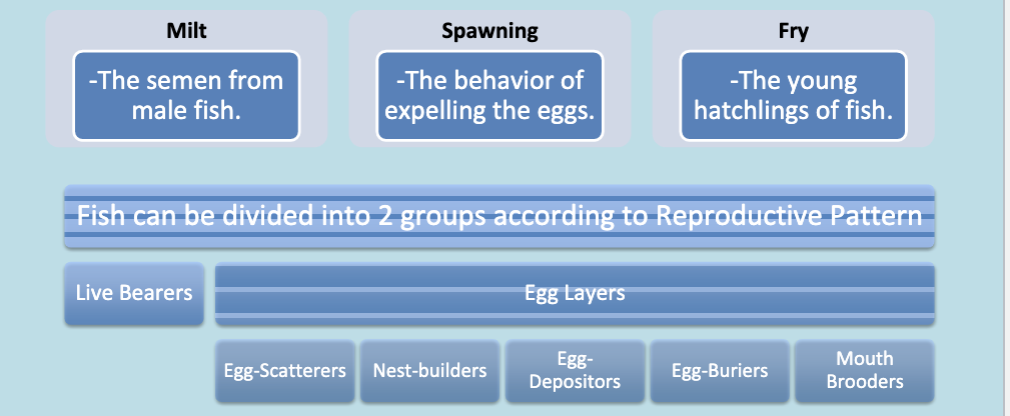
20
New cards
Egg-Scatters (ovi)
Egg scatters are divided into;
- Those lay adhesive eggs and will stick to any object in the aquarium (glass, marbles, decoration and plants)- Barbs and tetras fish. (top 2)
- Or fish whose eggs are not adhesive, and which simply fall to the bottom. Danios (such as zebras), koi and goldfish or fantails are typical non-adhesive egg layers. (bottom 2)
- They are laying a very large number of eggs, Once laid, there is no parental care of the eggs or fry (hatchlings).
- Almost all or at least 80% of the eggs are being eaten by other fishes in the aquarium.
- Those lay adhesive eggs and will stick to any object in the aquarium (glass, marbles, decoration and plants)- Barbs and tetras fish. (top 2)
- Or fish whose eggs are not adhesive, and which simply fall to the bottom. Danios (such as zebras), koi and goldfish or fantails are typical non-adhesive egg layers. (bottom 2)
- They are laying a very large number of eggs, Once laid, there is no parental care of the eggs or fry (hatchlings).
- Almost all or at least 80% of the eggs are being eaten by other fishes in the aquarium.
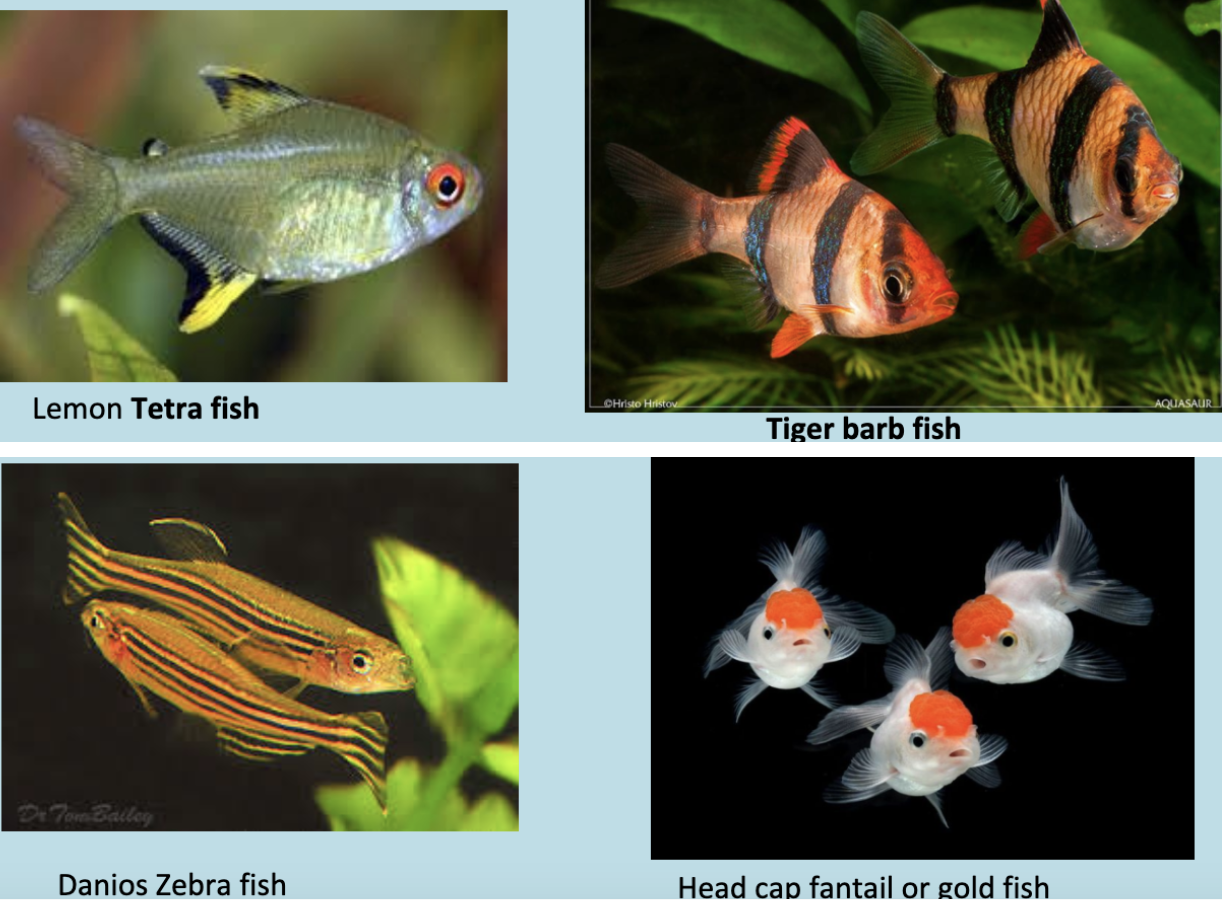
21
New cards
Things you can do to prevent egg-scatters eggs from being eaten
1. Reduce the light – encourage spawning and increases the number of eggs produced.
2. Have very dense plants – adults have difficulty swimming among plants to find eggs and fry.
3. Put glass marbles on the floor of the aquarium (couple of layers), eggs will settle between marbles and adults cannot get to them.
4. Use a spawning tank
2. Have very dense plants – adults have difficulty swimming among plants to find eggs and fry.
3. Put glass marbles on the floor of the aquarium (couple of layers), eggs will settle between marbles and adults cannot get to them.
4. Use a spawning tank
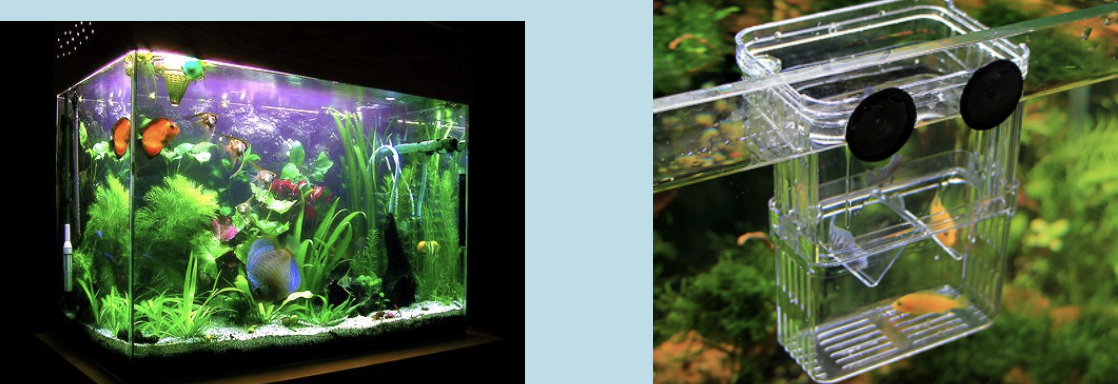
22
New cards
Egg-Depositors (ovi)
- They pick a suitable spot (glass, wood, rock, plants) to lay all their sticky eggs, female lays eggs and male fertilizes them.
- Parents usually take turns in guarding and cleaning eggs (excellent parents).
- When eggs hatch, parents protect fry from predators.
- They lay fewer and larger-sized eggs than egg scatters. Most cichlids (Discus, Oscar and Angel fish).
- Parents usually take turns in guarding and cleaning eggs (excellent parents).
- When eggs hatch, parents protect fry from predators.
- They lay fewer and larger-sized eggs than egg scatters. Most cichlids (Discus, Oscar and Angel fish).
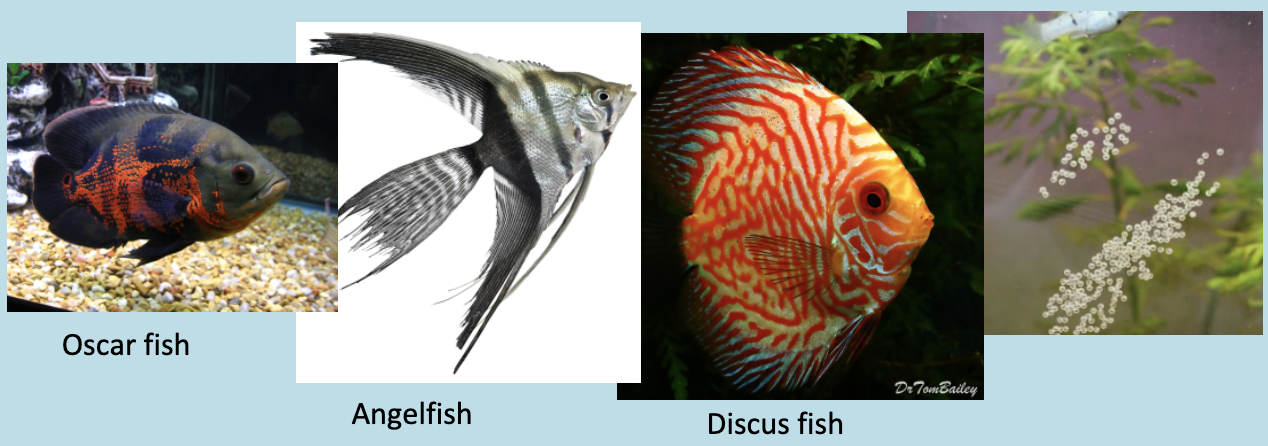
23
New cards
Nest-builders (ovi)
- Nest is usually constructed by the male, may be a saliva or slime blown bubble nest on the surface – or on bottom of the aquarium.
- Remove the female after eggs are fertilized – the male will become aggressive toward her.
- Male guards and tends the nest. Gouramis, Betta fish, and some cichlids.
- Remove the female after eggs are fertilized – the male will become aggressive toward her.
- Male guards and tends the nest. Gouramis, Betta fish, and some cichlids.

24
New cards
Egg-Buriers (ovi)
Annual killifish
- They live in rivers and ponds that dry up each year, before drying they lay eggs and bury then into the mud, and die when water dries, a few months later rain will return, eggs will hatch and a new generation will start
- They live in rivers and ponds that dry up each year, before drying they lay eggs and bury then into the mud, and die when water dries, a few months later rain will return, eggs will hatch and a new generation will start

25
New cards
How to breed Egg buriers in aquarium:
• Aquarium should have 2-3 inches of peat in bottom for these fish.
• Reduce the level of water gradually this will stimulate females to lay eggs
• Need to remove the peat with the eggs, squeeze out the water and store eggs in a sealed plastic bag for 2-3 months.
• Return peat to water for eggs to hatch since the water stimulate eggs to hatch
• Reduce the level of water gradually this will stimulate females to lay eggs
• Need to remove the peat with the eggs, squeeze out the water and store eggs in a sealed plastic bag for 2-3 months.
• Return peat to water for eggs to hatch since the water stimulate eggs to hatch

26
New cards
Mouth Brooders (ovi)
- Fish that carry their eggs in their mouth until they hatch, moreover hatched young generally are carried in mouth until they can fend for themselves.
- Eggs are laid by female, fertilized by male, then picked up by mouth in some species by the male, some other species by the female.
- Eggs incubate in the parents mouth for 2-3 weeks. Parent fish does not eat during this time.
Some Cichlids and some betta fish
- Eggs are laid by female, fertilized by male, then picked up by mouth in some species by the male, some other species by the female.
- Eggs incubate in the parents mouth for 2-3 weeks. Parent fish does not eat during this time.
Some Cichlids and some betta fish

27
New cards
Live bearers (Viviparous or Ovoviviparous)
- Viviparous – the internal young are nourished by the females
bloodstream
- Ovoviviparous – the internal young are kept inside the egg and
nourished by a yolk sac but inside the female body.
- The anal fin of the male is modified so that he can deposit milt into the vent of the female.
- Modification is called a gonopodium and can be used to identify the male of the species.
- Females can store milt in oviduct and produce several broods from 1 mating
bloodstream
- Ovoviviparous – the internal young are kept inside the egg and
nourished by a yolk sac but inside the female body.
- The anal fin of the male is modified so that he can deposit milt into the vent of the female.
- Modification is called a gonopodium and can be used to identify the male of the species.
- Females can store milt in oviduct and produce several broods from 1 mating
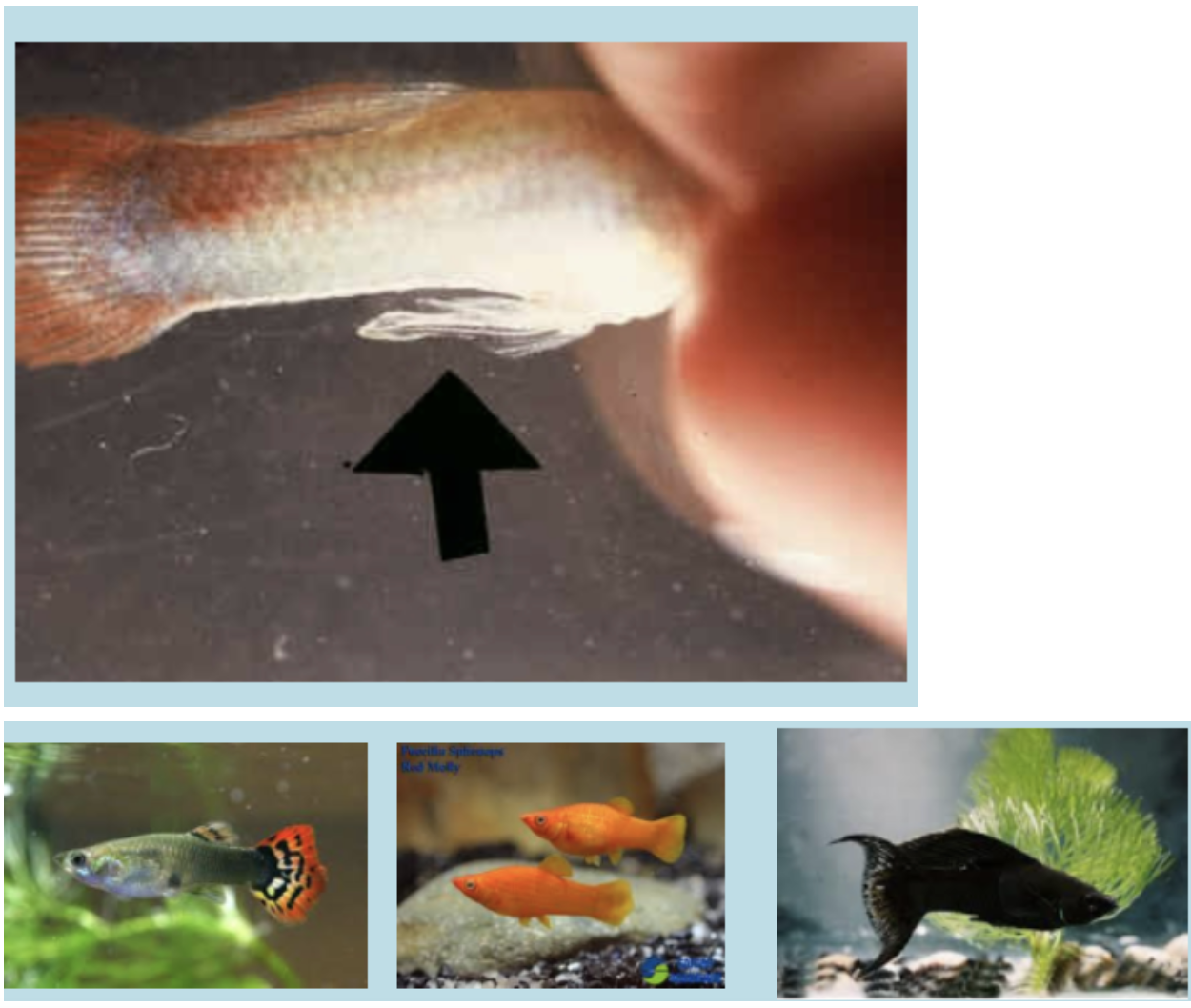
28
New cards
Feeding fish
Fish can be classified according to their feeding habit into;
- Carnivores, Herbivores, and Omnivores
Can also be based on the way they eat:
- Surface dwellers, mid-water dwellers, bottom dwellers
- Carnivores, Herbivores, and Omnivores
Can also be based on the way they eat:
- Surface dwellers, mid-water dwellers, bottom dwellers
29
New cards
Carnivores (fish)
meat-eating fish, their GIT can only digest animal-based diet with high protein content.
- They need not less than 45% protein in their diet (Earthworms, Red worms, Tubifex worms + Supplements in the form of flakes or granules and pellets for added nutrition)
(Some members of the cichlid family, Oscar and catfish)
- They need not less than 45% protein in their diet (Earthworms, Red worms, Tubifex worms + Supplements in the form of flakes or granules and pellets for added nutrition)
(Some members of the cichlid family, Oscar and catfish)
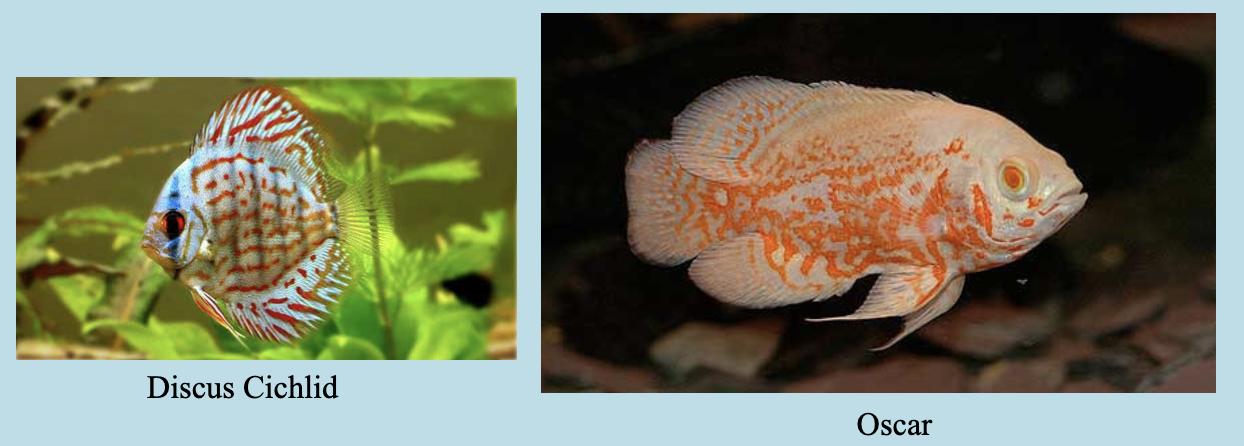
30
New cards
Herbivores (fish)
plant-eating fish, their GIT can only digest plant-based diet (also eat algae and live plants in the aquarium) and extract nutrients out of it. (Mollies)
- Cucumber, peas, and potatoes. These can be kept frozen and be chopped into tiny pieces at mealtime.
- Vegetable flakes come in a variety of flavors.
- Algal flakes will also be a favorite among this kind of fish.
>>>MAKE SURE TO REMOVE REMAINING TO AVOID DECAYING.<<<
- Cucumber, peas, and potatoes. These can be kept frozen and be chopped into tiny pieces at mealtime.
- Vegetable flakes come in a variety of flavors.
- Algal flakes will also be a favorite among this kind of fish.
>>>MAKE SURE TO REMOVE REMAINING TO AVOID DECAYING.<<<

31
New cards
Omnivores
eat pretty much anything, and that makes them dangerous to plants as well as to other smaller creatures in your aquarium, includes most of the aquarium fish.
- Cucumber, peas, and potatoes. These can be kept frozen and be chopped into tiny pieces at mealtime.
- Vegetable flakes come in a variety of flavors.
- Algal flakes will also be a favorite among this kind of fish.
>>>MAKE SURE TO REMOVE REMAINING TO AVOID DECAYING.<<<
- Cucumber, peas, and potatoes. These can be kept frozen and be chopped into tiny pieces at mealtime.
- Vegetable flakes come in a variety of flavors.
- Algal flakes will also be a favorite among this kind of fish.
>>>MAKE SURE TO REMOVE REMAINING TO AVOID DECAYING.<<<

32
New cards
Feeding styles of fish
- Surface feeders; can only eat from surface (Superior mouth)
- Bottom feeders; can only eat from the bottom of the water (Inferior mouth)
- Mid-water feeders; can eat from middle-level water, neither surface nor bottom (Terminal mouth).
- Bottom feeders; can only eat from the bottom of the water (Inferior mouth)
- Mid-water feeders; can eat from middle-level water, neither surface nor bottom (Terminal mouth).
33
New cards
Types of food
1- Type of food is mainly depending on the species (most of the fresh
water aquarium fish are omnivores)
- Fish should be fed 2 – 3 times a day, but only as much as they can eat
in 3 to 5 minutes.
- Over feeding and decayed organic matters are a major cause of
problems in an aquarium.
- Flake foods are ideal for fish up to about 5 inches long.
- Pellet food is good for larger fish and bottom feeding fish.
- Live foods is good source of protein and other essential elements. Brine Shrimp, river shrimp, earthworms, flies, maggots, mosquito larvae, tubifex worms, drosophila larvae
water aquarium fish are omnivores)
- Fish should be fed 2 – 3 times a day, but only as much as they can eat
in 3 to 5 minutes.
- Over feeding and decayed organic matters are a major cause of
problems in an aquarium.
- Flake foods are ideal for fish up to about 5 inches long.
- Pellet food is good for larger fish and bottom feeding fish.
- Live foods is good source of protein and other essential elements. Brine Shrimp, river shrimp, earthworms, flies, maggots, mosquito larvae, tubifex worms, drosophila larvae
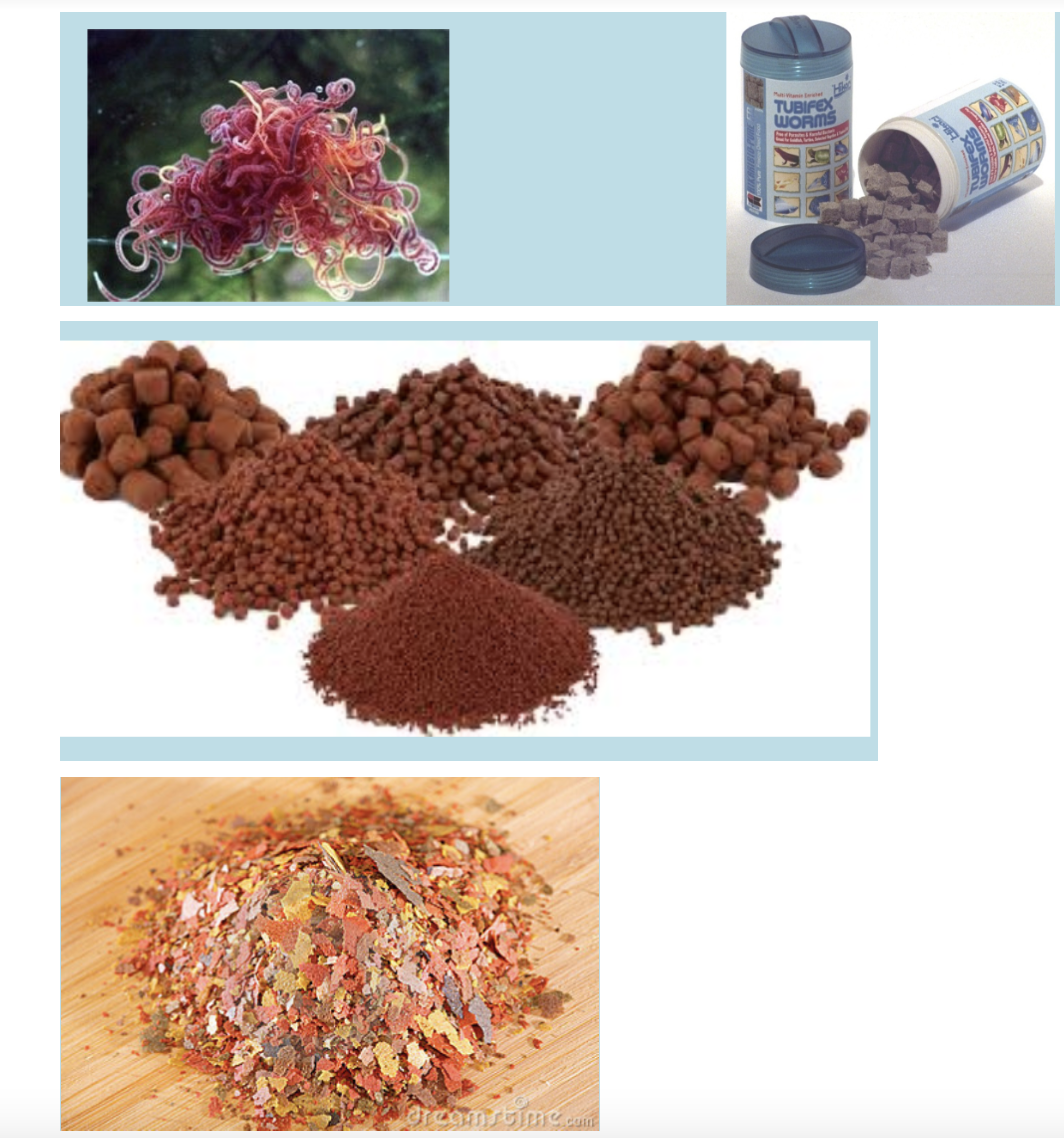
34
New cards
Vitamins and minerals in fish nutrition
- Calcium and phosphorus – fish need just like every other animal for nerves, muscles, etc. Don’t need much for bones – not as dense as other species, so bone is not a source during times of need.
- Ca++ and P uptake and excretion is regulated by thru the gills.
!!! Fish can use free minerals from the water. !!!
- Ca++ and P uptake and excretion is regulated by thru the gills.
!!! Fish can use free minerals from the water. !!!
35
New cards
Vitamins
most water-soluble vitamins will leech out of the food into the water in about 30 seconds after the food hits the water.
- While fat soluble vitamin will remain for a considerable time.
- Free floating vitamins in the water are too low a concentration to be of any use to the fish. Broken down by bacteria.
(75 to 90 % can be lost this way).
- Fish food is generally over formulated with vitamins to compensate for this loss.
- While fat soluble vitamin will remain for a considerable time.
- Free floating vitamins in the water are too low a concentration to be of any use to the fish. Broken down by bacteria.
(75 to 90 % can be lost this way).
- Fish food is generally over formulated with vitamins to compensate for this loss.
36
New cards
Vitamin C
especially important as fish cannot synthesize it.
- Important as an antioxidant and for cartilage formation.
- If you have a vitamin C deficiency, see a condition called lordosis – a curvature of the spine in the vertical plane. The head and tail are down and the middle of the spine is up.
- Other signs of Vitamin C deficiency include lethargy and generally poor health.
- Scoliosis (broken back disease) – similar to rickets, generally from a deficiency of Vitamin C, but can also be from Vitamin D or Tryptophan deficiency . Sideways curvature of spine – fish appears S-shaped if viewed from dorsal surface.
- Important as an antioxidant and for cartilage formation.
- If you have a vitamin C deficiency, see a condition called lordosis – a curvature of the spine in the vertical plane. The head and tail are down and the middle of the spine is up.
- Other signs of Vitamin C deficiency include lethargy and generally poor health.
- Scoliosis (broken back disease) – similar to rickets, generally from a deficiency of Vitamin C, but can also be from Vitamin D or Tryptophan deficiency . Sideways curvature of spine – fish appears S-shaped if viewed from dorsal surface.
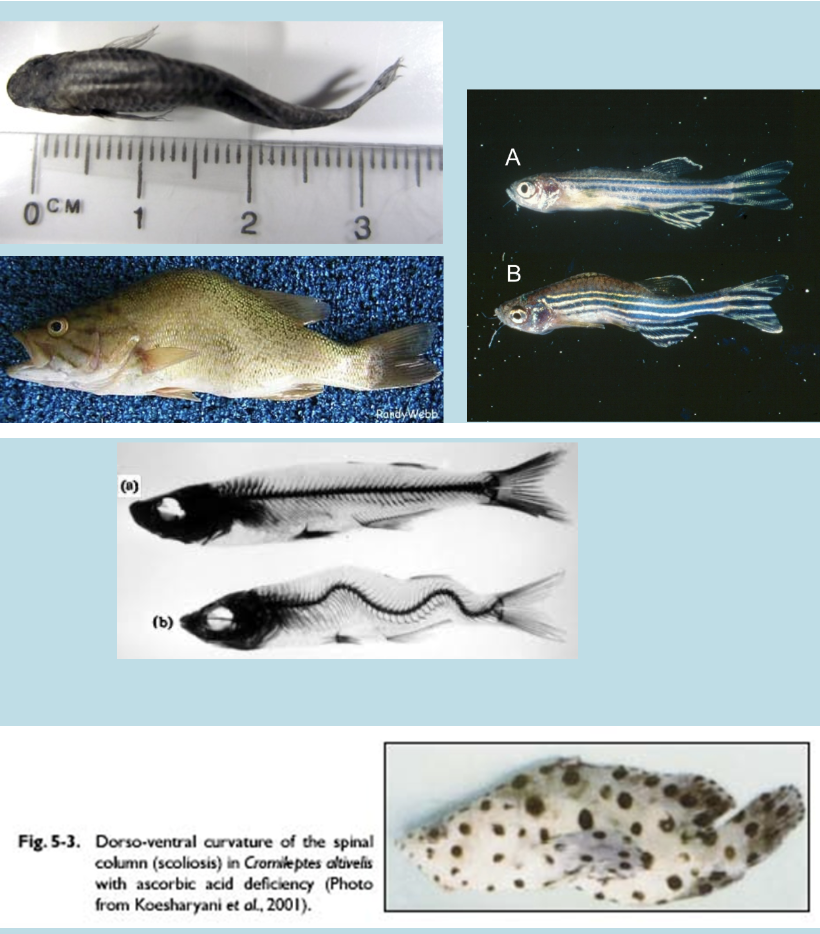
37
New cards
Aquarium Tank
1- Tank Shape
2- Tank Material
3- Tank Size and Dimensions
4- Location of the Tank
2- Tank Material
3- Tank Size and Dimensions
4- Location of the Tank
38
New cards
Tank Shape
The regular shape of the tank is horizontal rectangular, that shape guarantees the maximum water surface area which is very important for gas exchange.
- Modern shapes include cubes, vertical rectangular, or even panoramic tanks.
- It might be also built into a piece of furniture that often has shelves or closets to hide pumps and other equipment.
- However, the shape of the tank should maintain an adequate surface area to maintain adequate gas exchange.
- Modern shapes include cubes, vertical rectangular, or even panoramic tanks.
- It might be also built into a piece of furniture that often has shelves or closets to hide pumps and other equipment.
- However, the shape of the tank should maintain an adequate surface area to maintain adequate gas exchange.
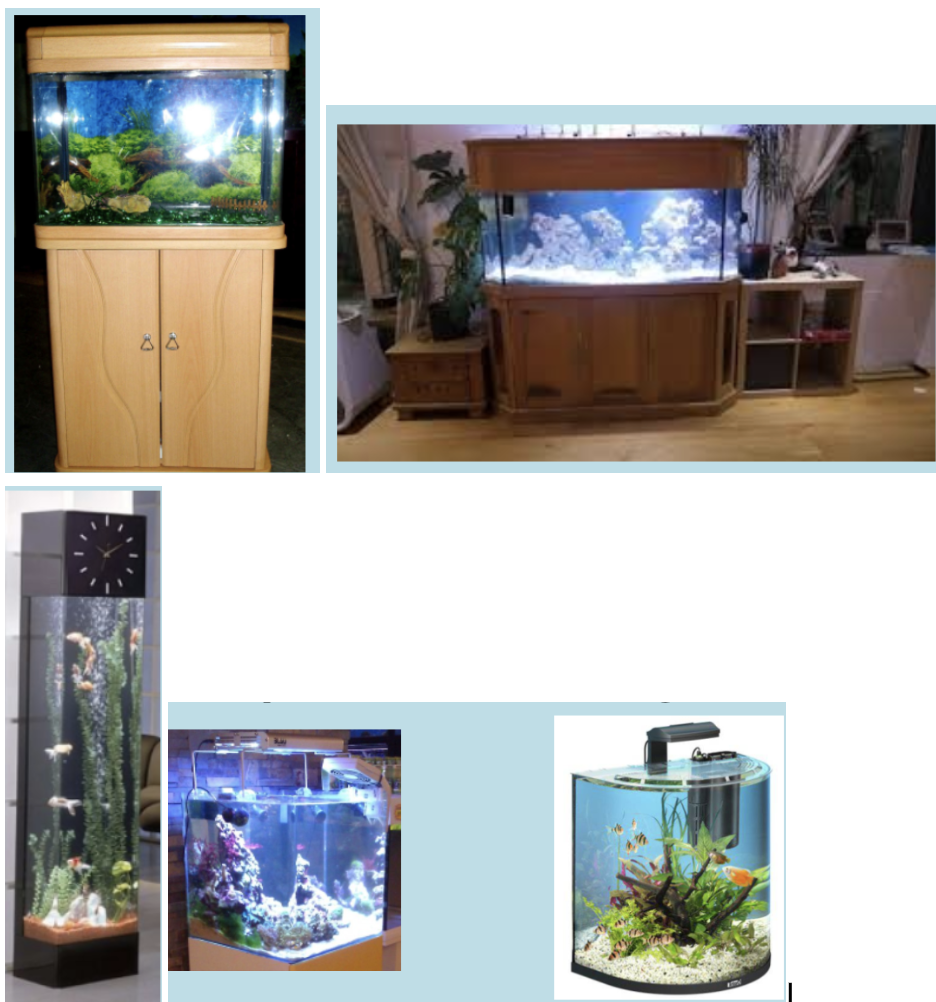
39
New cards
Tank Material
Most of the commercial tanks are made of glass assembled and glued together with Silicone joints; these materials are suitable for water volumes up to 500 liters. (you can do that yourself).
- For bigger volume tanks the polyester resin and cement are used with only the front side made of glass (public aquariums).
- Plexiglas is also used but it is very light, and durable and can be used for wonderful shapes (round aquarium) but it is easily scratchable and can not be used for very large volumes (bigger than glass and smaller than public aquarium).
- Plastic tanks, durable usually are made of inert plastic that does not react with water or any chemical but used only for small volumes tanks and enhances algae growth.
- For bigger volume tanks the polyester resin and cement are used with only the front side made of glass (public aquariums).
- Plexiglas is also used but it is very light, and durable and can be used for wonderful shapes (round aquarium) but it is easily scratchable and can not be used for very large volumes (bigger than glass and smaller than public aquarium).
- Plastic tanks, durable usually are made of inert plastic that does not react with water or any chemical but used only for small volumes tanks and enhances algae growth.
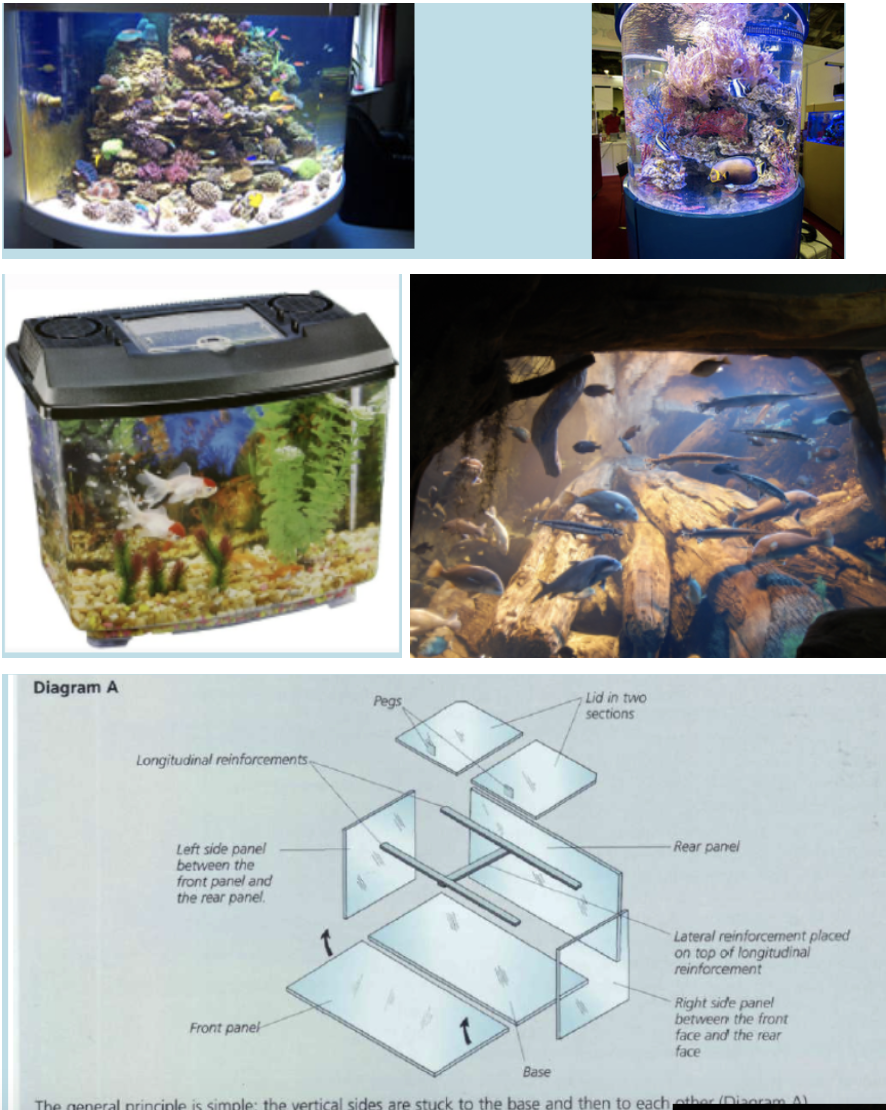
40
New cards
Tank Size and Dimensions
the general rule to maintain an adequate surface area is
"length = Height × 1.5-2.5”
“ Height is usually slightly greater than the width”
- This rule can be adhered to up to a length of 1.5m, as the height
should never exceed 0.5m, also not applied in built-in tanks.
- Tanks with higher ratio height will result in an inadequate surface area and irregular vertical distribution of Oxygen since the surface area is the only source for gas exchange.
(If not using mechanical Aerators)
- Also, very narrow tanks is a trick of the eye, since a tank seems one-third narrower when filled with water, producing an unfortunate visual effect.
"length = Height × 1.5-2.5”
“ Height is usually slightly greater than the width”
- This rule can be adhered to up to a length of 1.5m, as the height
should never exceed 0.5m, also not applied in built-in tanks.
- Tanks with higher ratio height will result in an inadequate surface area and irregular vertical distribution of Oxygen since the surface area is the only source for gas exchange.
(If not using mechanical Aerators)
- Also, very narrow tanks is a trick of the eye, since a tank seems one-third narrower when filled with water, producing an unfortunate visual effect.
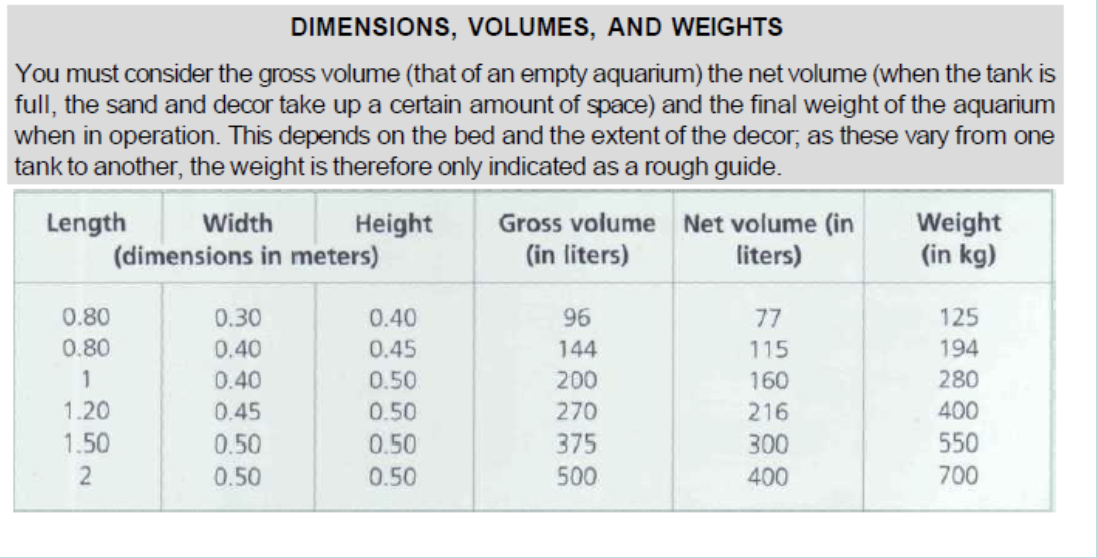
41
New cards
Location of the Tank
1- First, it is very important to consider the weight of the tank, and once it is filled it will be impossible to move is anywhere else
(2 * 0.5 * 0.5 = 700Kg). So needs solid support.
2- Away from direct sunlight; will enhance the growth of algae and raise temp. during the summer season.
3- Don’t put on top of a radiator or in front of a heater; will affect the water temp. and results in irregular distribution of water temp.
4- A place where you can watch it, usually a fairly dark spot to highlight it.
5- Away from possibly damaging activity (children and cats), and close to an electrical outlet.
6- Well used living area – fish can acclimate to people entering and leaving the room.
7- Location that will tolerate a water spill or splash.
8- Putting any electrical devices under the aquarium: this is dangerous, due to the possibility of water spilling.
(2 * 0.5 * 0.5 = 700Kg). So needs solid support.
2- Away from direct sunlight; will enhance the growth of algae and raise temp. during the summer season.
3- Don’t put on top of a radiator or in front of a heater; will affect the water temp. and results in irregular distribution of water temp.
4- A place where you can watch it, usually a fairly dark spot to highlight it.
5- Away from possibly damaging activity (children and cats), and close to an electrical outlet.
6- Well used living area – fish can acclimate to people entering and leaving the room.
7- Location that will tolerate a water spill or splash.
8- Putting any electrical devices under the aquarium: this is dangerous, due to the possibility of water spilling.
42
New cards
The tank cover
(Hood/ lid or both)
- It is 2 separate covers - Hood; glass, wood or plastic, containing light source and is highly decorated and - Lid; glass cover directly above water surface and under the hood
- It is necessary for several reasons:
1- To stop dust falling into the water
2- To prevent any possible jumping fish escaping from the tank
3- To reduce water evaporation
4- The hood contains the light sources, and the lid prevent water spilling on the lighting hood
- It is 2 separate covers - Hood; glass, wood or plastic, containing light source and is highly decorated and - Lid; glass cover directly above water surface and under the hood
- It is necessary for several reasons:
1- To stop dust falling into the water
2- To prevent any possible jumping fish escaping from the tank
3- To reduce water evaporation
4- The hood contains the light sources, and the lid prevent water spilling on the lighting hood
43
New cards
An artificial light-Source
is usually supplied to the aquarium in the hood cover.
- Light does not only serve to provide visual pleasure and highlight the
aquarium, it is also essential for fish, like most living beings need the
alternation of day and night to adjust their biological homeostasis.
- As a general rule, the use of fluorescent tubes is generally
recommended (LED is also a good option)
- You must consider the light intensity and loss “ A fair light intensity should be evenly distributed throughout the aquarium”
- The distance between the light source and the water surface depends on
Light loss:
- Glass lid might be used to cover the aquarium
- Reflected light by the water surface
- Absorbed light by water and impurities
- Light does not only serve to provide visual pleasure and highlight the
aquarium, it is also essential for fish, like most living beings need the
alternation of day and night to adjust their biological homeostasis.
- As a general rule, the use of fluorescent tubes is generally
recommended (LED is also a good option)
- You must consider the light intensity and loss “ A fair light intensity should be evenly distributed throughout the aquarium”
- The distance between the light source and the water surface depends on
Light loss:
- Glass lid might be used to cover the aquarium
- Reflected light by the water surface
- Absorbed light by water and impurities
44
New cards
Light Duration (in tanks)
In tropical and subtropical regions, the day light lasts for approximately 11 to 13 hours, and this is what wild plants and fish are accustomed to.
- Also, different types of light sources and colors are used for decorative purposes.
- Also, different types of light sources and colors are used for decorative purposes.
45
New cards
The bedding (in tanks)
has several roles; decorative role and also a biological role that is no less important.
1- It contains bacteria that contribute to the nitrogen cycle (involved in
the elimination of nitrogenous compounds).
2- Enable plants to take root.
3- Must look both visually pleasing and natural
4- Depth is usually from 5-8 cm depends on the type of bed
5-You might use; - Coarse and fine gravel - Quartz sand (comes
from granite rock) - Pozzolana and other volcanic rocks
- Peat (in case of egg buriers; kellies fish)
1- It contains bacteria that contribute to the nitrogen cycle (involved in
the elimination of nitrogenous compounds).
2- Enable plants to take root.
3- Must look both visually pleasing and natural
4- Depth is usually from 5-8 cm depends on the type of bed
5-You might use; - Coarse and fine gravel - Quartz sand (comes
from granite rock) - Pozzolana and other volcanic rocks
- Peat (in case of egg buriers; kellies fish)
46
New cards
The Water in Tanks
Water parameters:
o pH
o Temperature
o Oxygen
o Hardness
o Nitrogen cycle
o Water turbidity
o pH
o Temperature
o Oxygen
o Hardness
o Nitrogen cycle
o Water turbidity
47
New cards
Water acidity and alkalinity (pH)
- The pH measures the acidity or alkalinity of water, with the value 7 representing neutrality.
- Below this level the water is acid, and above it the water is alkaline.
- Most of the fresh water aquarium must live in neutral or slightly acidic pH (6.5-7), improper pH has fatal consequences on fish and other living organisms in water.
Very low and Very high pH are Fatal
- Normal variation in pH; are mainly the result of biological activity: the carbon dioxide produced by living beings acidifies the water at night and the pH goes down slightly.
- Once the carbon dioxide has been absorbed by the plants and algae during the day the pH goes up again.
- Regular pH monitoring is the best practice to test water equilibrium and fish health as well. And it is very important to adjust water pH to the required level.
- Below this level the water is acid, and above it the water is alkaline.
- Most of the fresh water aquarium must live in neutral or slightly acidic pH (6.5-7), improper pH has fatal consequences on fish and other living organisms in water.
Very low and Very high pH are Fatal
- Normal variation in pH; are mainly the result of biological activity: the carbon dioxide produced by living beings acidifies the water at night and the pH goes down slightly.
- Once the carbon dioxide has been absorbed by the plants and algae during the day the pH goes up again.
- Regular pH monitoring is the best practice to test water equilibrium and fish health as well. And it is very important to adjust water pH to the required level.
48
New cards
Temperature (in fish tanks)
unlike mammals, fish are ectotherms, they can not regulate their body temperature and depend mainly on the environmental temp. in regulating their body temp.
– The most optimum water temp. for most of
freshwater fish is = 25o C (77o F) with 2oC variation.
- Fish can live in very low or high temp. but this will have a determinal impact on their health, increase the incidence of disease and usually ends with death.
- Avoid temp. shock; sudden change in water temp. will result in
cardiogenic, vasogenic shock and immediate death of the fish.
- Some Cold fish: Common goldfish. Celestial Pearl Danio. Buenos Aires tetra (60 °F (15 °C))
- Their energy requirements will vary directly with the temperature of the environment.
- Cold environment – low metabolic rate and low energy requirement, less feeding and less growth and reproduction
- Warm environment – higher metabolic rate and higher energy requirement, more feeding and more growth and reproduction
- At about 5oC (41oF) almost all metabolism will stop in fish.
- It is very important to monitor water temp. regularly (Thermometer), add water heater supplied with a thermostat.
– The most optimum water temp. for most of
freshwater fish is = 25o C (77o F) with 2oC variation.
- Fish can live in very low or high temp. but this will have a determinal impact on their health, increase the incidence of disease and usually ends with death.
- Avoid temp. shock; sudden change in water temp. will result in
cardiogenic, vasogenic shock and immediate death of the fish.
- Some Cold fish: Common goldfish. Celestial Pearl Danio. Buenos Aires tetra (60 °F (15 °C))
- Their energy requirements will vary directly with the temperature of the environment.
- Cold environment – low metabolic rate and low energy requirement, less feeding and less growth and reproduction
- Warm environment – higher metabolic rate and higher energy requirement, more feeding and more growth and reproduction
- At about 5oC (41oF) almost all metabolism will stop in fish.
- It is very important to monitor water temp. regularly (Thermometer), add water heater supplied with a thermostat.
49
New cards
Water hardness and chlorinated water
- Most of the cities' tap water is chlorinated and can not be used directly for filling aquarium tank since chlorine itself is toxic and harm fish gills, also will immediately bind with Na ion and increases water salinity (fatal for freshwater fish).
- Water Dechlorination can be done by several means;
1- By letting water sit for several days (It is a halogen)
2- Can use distilled water for setup
3- Run mechanical aerator for 12-24 hours
4- Commercial dechlorinators are available.
- Water hardness; the mineral level of the water is usually due to a combination of substances based on Ca and Mg contained in water.
There are 2 types of hardness – temporary and permanent.
- Temporary is caused by carbonate and bicarbonate ions and directly reflects the buffering capacity (pH) of the water.
- It can be precipitated and removed by boiling the water; This is why lime-scale forms in kettles and shower heads.
- Permanent hardness measures ions such as nitrates, sulfates, and chlorides etc, and cannot be removed by boiling. (Water with high level of Hardness called hard water, while low level of Hardness called soft water)
- Both hard and soft water cause stress and might lead to fish death, also would affect the water pH level that is crucial to healthy and happy aquatic life.
- There are a lot of water softeners which work by precipitating the Ca and Mg salt and convert them into insoluble substances.
- Water Dechlorination can be done by several means;
1- By letting water sit for several days (It is a halogen)
2- Can use distilled water for setup
3- Run mechanical aerator for 12-24 hours
4- Commercial dechlorinators are available.
- Water hardness; the mineral level of the water is usually due to a combination of substances based on Ca and Mg contained in water.
There are 2 types of hardness – temporary and permanent.
- Temporary is caused by carbonate and bicarbonate ions and directly reflects the buffering capacity (pH) of the water.
- It can be precipitated and removed by boiling the water; This is why lime-scale forms in kettles and shower heads.
- Permanent hardness measures ions such as nitrates, sulfates, and chlorides etc, and cannot be removed by boiling. (Water with high level of Hardness called hard water, while low level of Hardness called soft water)
- Both hard and soft water cause stress and might lead to fish death, also would affect the water pH level that is crucial to healthy and happy aquatic life.
- There are a lot of water softeners which work by precipitating the Ca and Mg salt and convert them into insoluble substances.
50
New cards
Water aeration (O2/Co2 level)
- Since air contains around 20% oxygen, even the most oxygenated water rarely contains more than 1% dissolved oxygen.
- Respiration in fish is mainly by extracting dissolved oxygen from water by gills.
- The oxygen in water comes from the dissolution of the oxygen in the air, a process enhanced by movements in the water produced by the wind (Natural mechanical aeration).
- Using mechanical aerators or air pump is a very good practice to maintain optimum level of dissolved O2 and eliminate Co2 in the water
- Respiration in fish is mainly by extracting dissolved oxygen from water by gills.
- The oxygen in water comes from the dissolution of the oxygen in the air, a process enhanced by movements in the water produced by the wind (Natural mechanical aeration).
- Using mechanical aerators or air pump is a very good practice to maintain optimum level of dissolved O2 and eliminate Co2 in the water
51
New cards
Nitrogen cycle in the aquarium
After introducing fish to the aquarium they immediately begin to release waste into the water in the form of excreta and body secretions, both of which contain Nitrogen, also decayed organic matters and waste product of algae contain Nitrogen .
- Nitrogen in the water is quickly converted into Ammonia or Ammonium (NH3, NH4), which are highly toxic to almost all the animals, particularly fish, result in severe irritation of fish gills, eyes, and skin (1 mg/L is toxic level).
- Also, they tend to bind with dissolved oxygen (result in the formation of nitrite and nitrates; NO2 and NO3) which might lead to hypoxia (reduced oxygen level in water) and fish suffocation.
- Beneficial bacteria populations (Nitrosomonas and Nitrobacter = nitrogen fixing bacteria) are responsible for nitrogen cycle in the water.
- Bacterial colonies rapidly utilize ammonia and convert them into Nitrites then into Nitrates as part of their metabolism, Nitrates then can be used as (absorbed) a fertilizer and metabolic enhancer for the plants and algae in the aquarium or can be (assimilated) during the gas exchange or removed by water filtration.
- Nitrogen in the water is quickly converted into Ammonia or Ammonium (NH3, NH4), which are highly toxic to almost all the animals, particularly fish, result in severe irritation of fish gills, eyes, and skin (1 mg/L is toxic level).
- Also, they tend to bind with dissolved oxygen (result in the formation of nitrite and nitrates; NO2 and NO3) which might lead to hypoxia (reduced oxygen level in water) and fish suffocation.
- Beneficial bacteria populations (Nitrosomonas and Nitrobacter = nitrogen fixing bacteria) are responsible for nitrogen cycle in the water.
- Bacterial colonies rapidly utilize ammonia and convert them into Nitrites then into Nitrates as part of their metabolism, Nitrates then can be used as (absorbed) a fertilizer and metabolic enhancer for the plants and algae in the aquarium or can be (assimilated) during the gas exchange or removed by water filtration.
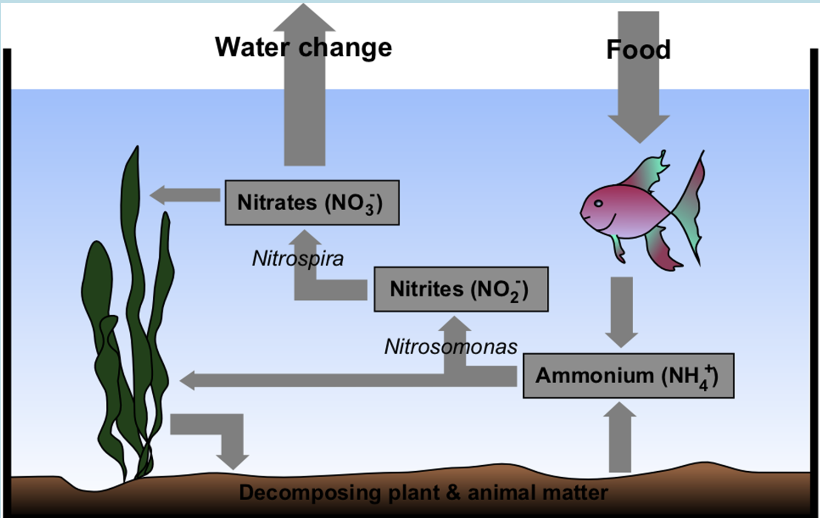
52
New cards
New Tank Syndrome
is when fish, recently introduced to a new tank, die off due to high levels of ammonia, nitrates and nitrites in the water before sufficient bacteria levels can be established.
53
New cards
Establishing nitrogen cycle in new aquarium
1. Using Fish Food; Drop in a few flakes every 12 hours. As the food decomposes it will release ammonia. Continue to "feed" the tank throughout the process to keep it going.
2. Use a small piece of raw fish or a raw shrimp; Drop a 2 inch by a 1-inch chunk of raw fish or a raw shrimp into the tank. As it decomposes it will release ammonia into the tank.
3. Use 100% pure ammonia; Add 5 drops of ammonia per 10 gallons of aquarium water. Continue this process daily until you start to get nitrite readings with your test kit. Once you detect nitrites, add 3 drops of ammonia per 10 gallons of aquarium water. Continue this process daily until you get nitrate readings with your test kit. Do a 30% water change and your tank is ready.
4. Use gravel and/or filter media from an established and cycled tank; This is the best and fastest way to go. This will seed the tank with all of the necessary bacteria for the nitrogen cycle. "Feed" the tank daily with flake food until you get nitrate readings. Depending on how fast you are able to get the gravel and filter media into your tank, it may only take a day or two to get nitrate readings.
5. Use commercial preparations of bacteria to seed your tank
2. Use a small piece of raw fish or a raw shrimp; Drop a 2 inch by a 1-inch chunk of raw fish or a raw shrimp into the tank. As it decomposes it will release ammonia into the tank.
3. Use 100% pure ammonia; Add 5 drops of ammonia per 10 gallons of aquarium water. Continue this process daily until you start to get nitrite readings with your test kit. Once you detect nitrites, add 3 drops of ammonia per 10 gallons of aquarium water. Continue this process daily until you get nitrate readings with your test kit. Do a 30% water change and your tank is ready.
4. Use gravel and/or filter media from an established and cycled tank; This is the best and fastest way to go. This will seed the tank with all of the necessary bacteria for the nitrogen cycle. "Feed" the tank daily with flake food until you get nitrate readings. Depending on how fast you are able to get the gravel and filter media into your tank, it may only take a day or two to get nitrate readings.
5. Use commercial preparations of bacteria to seed your tank
54
New cards
Water turbidity
(suspended matters; decomposed plants, feces, food, urine, dust and other impurities).
- Accumulation of this substance is very harmful to fish health and
wellbeing; reduce light, prevent the uniform distribution of temp and O2, increase the incidence of diseases, and reduces the gills ability to absorb dissolved oxygen.
- So, Water Filtration is very important Water Filter might be;
a. Under bed or gravel (very important also for keeping nitrogen fixing bacteria
b. inside or outside the aquarium with activated charcoal and filter wool
- Accumulation of this substance is very harmful to fish health and
wellbeing; reduce light, prevent the uniform distribution of temp and O2, increase the incidence of diseases, and reduces the gills ability to absorb dissolved oxygen.
- So, Water Filtration is very important Water Filter might be;
a. Under bed or gravel (very important also for keeping nitrogen fixing bacteria
b. inside or outside the aquarium with activated charcoal and filter wool
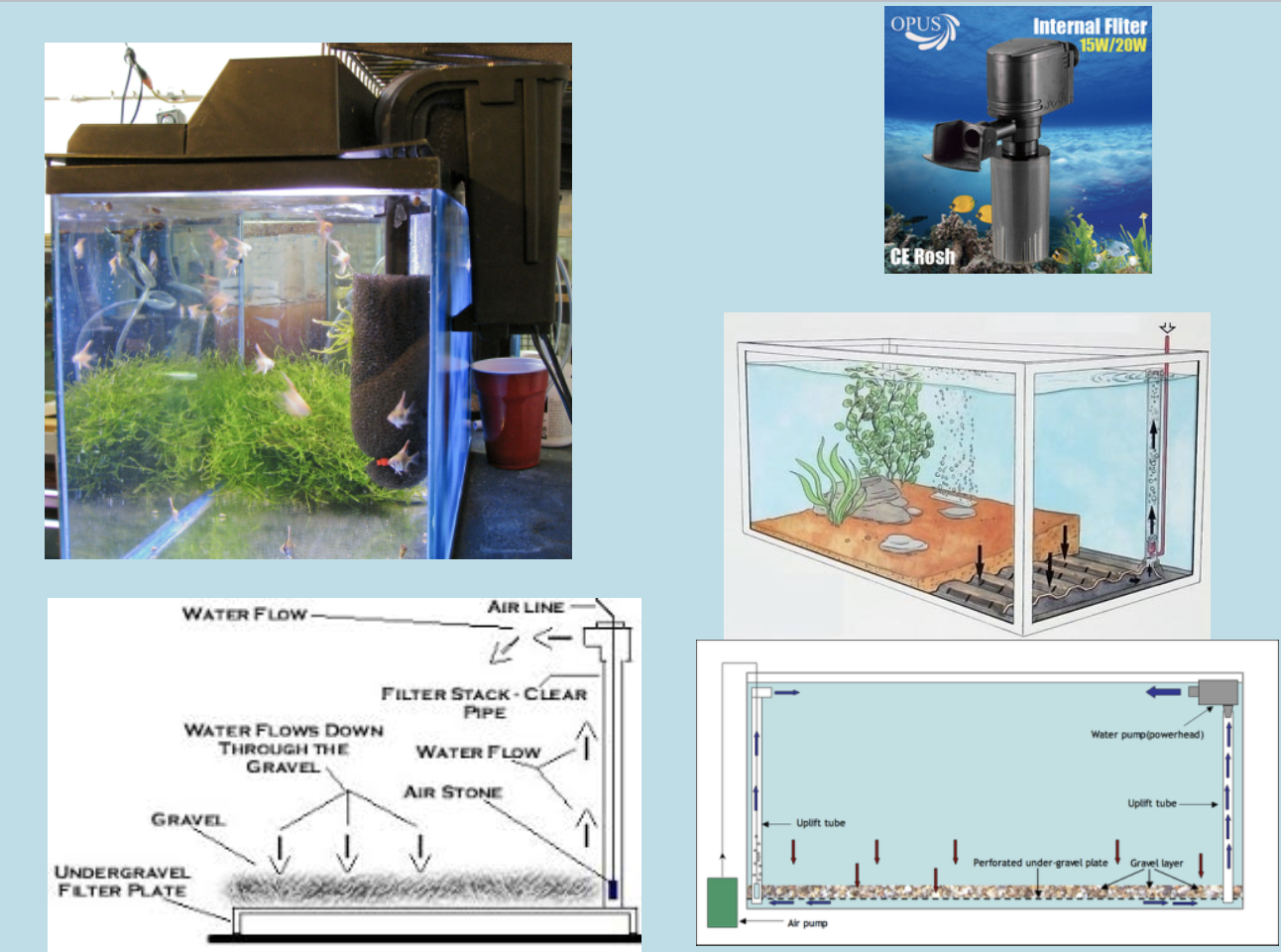
55
New cards
Mechanical filtration
- By changing a portion of the water regularly in order to remove large debris and keep the aquarium looking nice.
- Or by using an actual filter (recommended), involves passing water through a fine filter medium (silica sand, wool, fine gravel) to remove any suspended particles from the water.
- Or by using an actual filter (recommended), involves passing water through a fine filter medium (silica sand, wool, fine gravel) to remove any suspended particles from the water.
56
New cards
Biological filtration
is a more important type of filtration.
- Microorganisms are present in the filter which convert harmful substances into less toxic substances.
- This is especially important for fish because it reduces toxic ammonia and ammonium into less toxic nitrites, nitrates, and sometimes elemental nitrogen (Nitrogen fixing bacteria).
- Plants and algae also act as a biological filter to some extent, especially in the reduction of ammonium.
- Microorganisms are present in the filter which convert harmful substances into less toxic substances.
- This is especially important for fish because it reduces toxic ammonia and ammonium into less toxic nitrites, nitrates, and sometimes elemental nitrogen (Nitrogen fixing bacteria).
- Plants and algae also act as a biological filter to some extent, especially in the reduction of ammonium.
57
New cards
Chemical filtration
uses adsorption process to remove organic pollutants, which cannot be handled by biological or mechanical filtration (particles and nutrients from metabolic waste; organic acids, proteins, hormones, antibiotic compounds, organic compounds, also many elements from the surrounding air; such as pesticides, nicotine, and perfumes etc) (Adsorption is the process where the chemical compounds bind to the surface of the media used to remove it from the water)
58
New cards
Disadvantage of Chemical filtration
it is not selective in what it removes; It will remove both harmful and beneficial substances, which is not ideal for an aquarium. Therefore, using this type of filtration as a long-term solution is not a good idea.
(Activated charcoal is a type of chemical filtration)
(Activated charcoal is a type of chemical filtration)
59
New cards
Ornamentation and decoration
- Don’t use coral, limestone, marble in freshwater tanks
- No metal other than stainless steel
- Many plastic and china/ceramic items available
- Rocks, drift wood, wood (boiled several times)
- Try to make aquarium look as natural as original habitat.
- Provide shelter or hiding places for some species.
- No metal other than stainless steel
- Many plastic and china/ceramic items available
- Rocks, drift wood, wood (boiled several times)
- Try to make aquarium look as natural as original habitat.
- Provide shelter or hiding places for some species.
60
New cards
Plants – Live vs. Plastic
- Live plants – floating and rooted – huge variety to choose from, they will utilize CO2 and release O2, participate in the nitrogen cycle, hiding places, food for some species of fish.
- Need about 10 to 14 hours of light per day
- Not a good idea to use plants from pond or lake – may have bacteria, algae, viruses, bugs, snails, etc.
- Plastic plants – huge variety of sizes, shapes, colors, and quality.
- Use plastic plants designed for the aquarium.
- Need about 10 to 14 hours of light per day
- Not a good idea to use plants from pond or lake – may have bacteria, algae, viruses, bugs, snails, etc.
- Plastic plants – huge variety of sizes, shapes, colors, and quality.
- Use plastic plants designed for the aquarium.
61
New cards
Ways to protect your tank from the plants/diseases they may carry
1- Potassium permanganate; Ten minute soak. This is particularly effective against bacteria.
2- Lime it from Aquatronics ; An aquarium product effective against
snail eggs and bacteria
3- Household bleach: 1 part bleach to 19 parts water. Effective against pathogens, algae, and snails. Soak for two minutes and rinse completely with clear water and de-chlorinator.
2- Lime it from Aquatronics ; An aquarium product effective against
snail eggs and bacteria
3- Household bleach: 1 part bleach to 19 parts water. Effective against pathogens, algae, and snails. Soak for two minutes and rinse completely with clear water and de-chlorinator.
62
New cards
Stocking density and species population
- The general rule for the stocking density of small species is
“1 cm of fish per 1 liter of fresh water”
(see table for precise calculations).
“1 cm of fish per 1 liter of fresh water”
(see table for precise calculations).
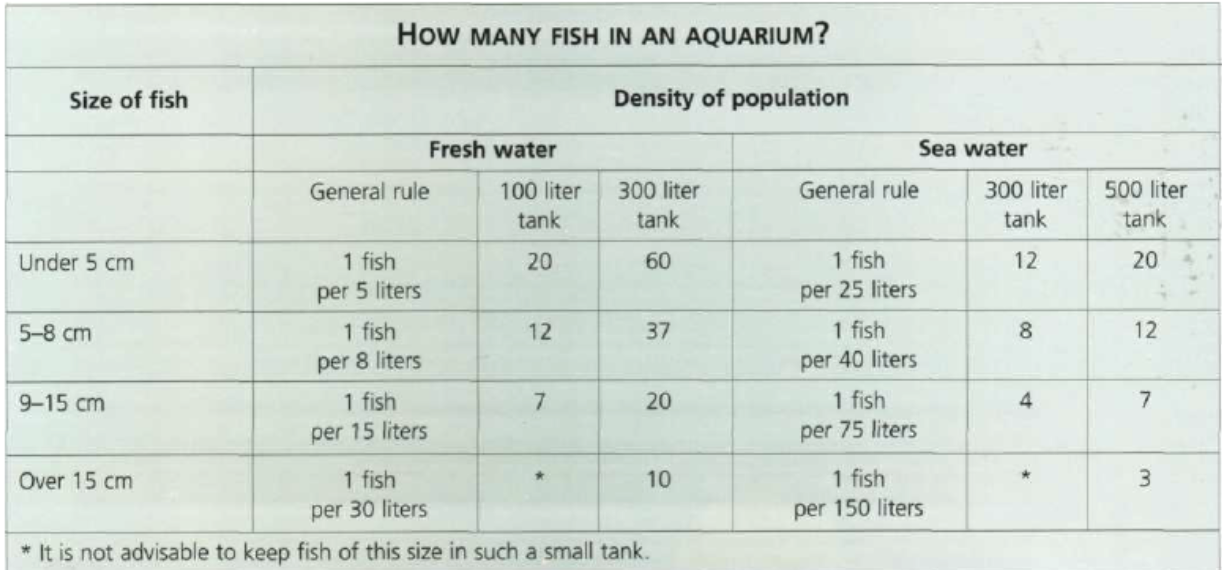
63
New cards
You must pay great attention for the collection of species you might have in your aquarium;
- Aggressive carnivores must be raised separated from other fish, and must be of equal size.
- Nest builders are preferred to be kept alone during reproduction since they tend to be very aggressive.
- Try to make efficient use of the tank by combing surface, midwater and bottom dwellers/feeders fish in your aquarium.
- Also, try to keep algae-feeders fish in your aquarium (e.g Plecostomus
fish) they will regularly prevent overpopulation of algae and clean aquarium glass surfaces.
- Nest builders are preferred to be kept alone during reproduction since they tend to be very aggressive.
- Try to make efficient use of the tank by combing surface, midwater and bottom dwellers/feeders fish in your aquarium.
- Also, try to keep algae-feeders fish in your aquarium (e.g Plecostomus
fish) they will regularly prevent overpopulation of algae and clean aquarium glass surfaces.
64
New cards
Fresh water aquarium fish
diff types (be able to recognize them and know their key characteristics)
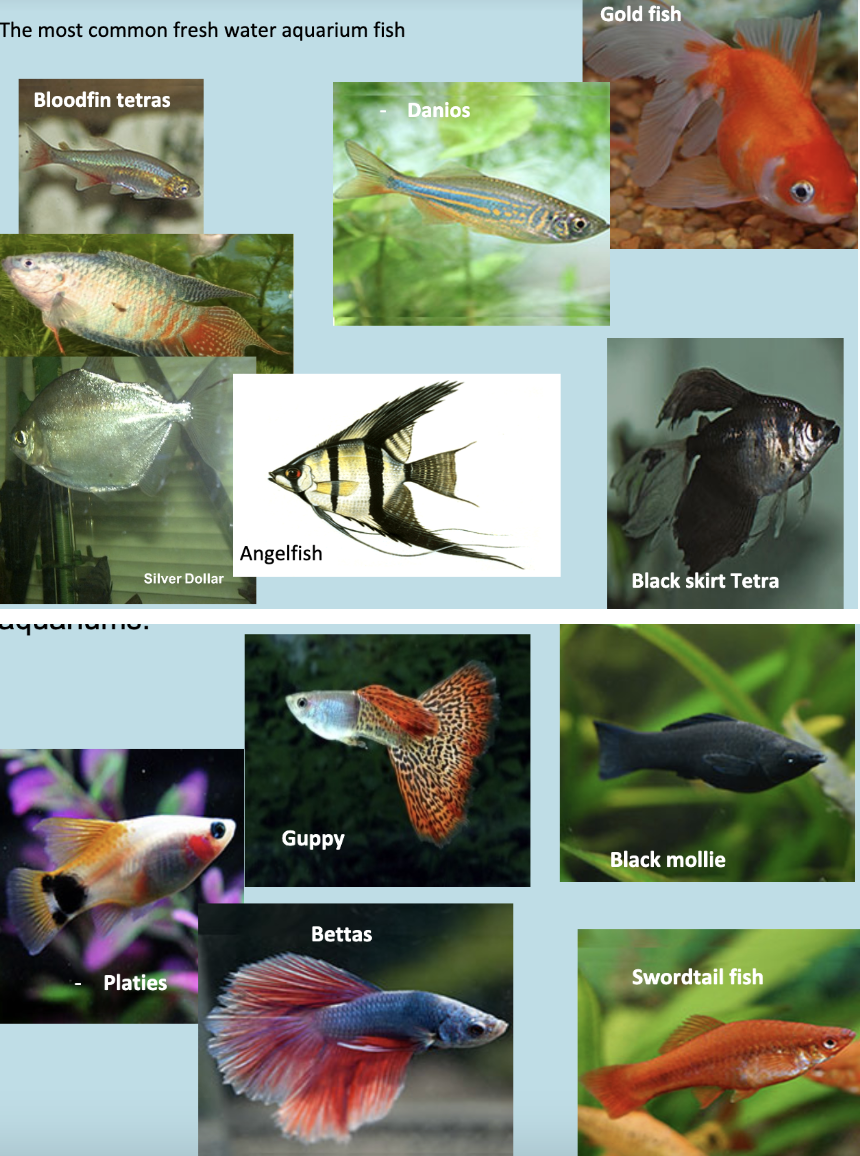
65
New cards
Fish Diseases
Diseases can be of a variety of causes:
1.Viral diseases
2. Bacterial diseases
3. Fungal diseases
4. Protozoal diseases
5. Parasitic diseases
6. Nutritional deficiencies
7. Metabolic diseases
8. Toxic agents
1.Viral diseases
2. Bacterial diseases
3. Fungal diseases
4. Protozoal diseases
5. Parasitic diseases
6. Nutritional deficiencies
7. Metabolic diseases
8. Toxic agents
66
New cards
Diseases transmission in Freshwater aquarium
1- Most diseases usually occur when fish is first taken home and added to the aquarium; Once established in the aquarium, Fish usually don’t come into contact with other fish and so transmission of the disease is not very common.
2- New fish should go through a period of quarantine and observation, before being added to the aquarium; newly introduced fish are the most common source of infection.
3 – You are the most likely source of infection for the aquarium,
never interact with aquarium water before totally sanitize and rinse
your hand.
2- New fish should go through a period of quarantine and observation, before being added to the aquarium; newly introduced fish are the most common source of infection.
3 – You are the most likely source of infection for the aquarium,
never interact with aquarium water before totally sanitize and rinse
your hand.
67
New cards
Most common fish diseases
1- Ich (White Spot Disease)
2- Slime Disease in fish
3- Fish Flukes
4- Hole in the head disease
5- Fungal Infections (Cotton Wool Disease)
6- Fin rot
7- Mouth Fungus (cotton-mouth disease)
2- Slime Disease in fish
3- Fish Flukes
4- Hole in the head disease
5- Fungal Infections (Cotton Wool Disease)
6- Fin rot
7- Mouth Fungus (cotton-mouth disease)
68
New cards
Ich (White Spot Disease)
– Caused by the ciliate protozoan Ichthyophthirius multifiliis.
- It is probably the most important disease of freshwater aquarium fishes, and essentially all aquarium fish are susceptible to the infection.
Clinical and behavioral signs:
1- Clinical findings: Small white pimples (salt or sugar granules =
tissue reaction ?) throughout the body or may be concentrated mainly
on the fins.
- Behavioral findings: (due to skin irritation)
1- Anorexia (loss of appetite, refusing all food, emaciation)
2- Rapid breathing due to stress
(mouth opening and movement of the operculum)
3- The fish is not schooling (isolate itself), or resting on the bottom
4- Rubbing and scratching against objects - Called “Flashing”
Complications:
- Skin damage and loss of the slime layer
- Opens an entry to infection with 2ry bacterial, fungal or viral disease
- Usually ends with death within few days If not treated.
Diagnosis and treatment:
1- Clinical and behavioral signs (white spots)
2- Microscopic examination of skin and gills. Remove several "white spots" from an infected fish, then mount them on a microscope slide with a few drops of water (Trophont = horse-shoe nucleus).
ch can only be killed in the Theront stage
- Increase temperature of tank to 78 – 80o F to speed up life cycle of the organism:
Convert all the stages to Theront and then apply chemical treatment.
Formaldehyde, Metronidazole, Aquarium salt and salt of malachite green drops into water and fish salt bath 2% or salt dip 5%.
- It is probably the most important disease of freshwater aquarium fishes, and essentially all aquarium fish are susceptible to the infection.
Clinical and behavioral signs:
1- Clinical findings: Small white pimples (salt or sugar granules =
tissue reaction ?) throughout the body or may be concentrated mainly
on the fins.
- Behavioral findings: (due to skin irritation)
1- Anorexia (loss of appetite, refusing all food, emaciation)
2- Rapid breathing due to stress
(mouth opening and movement of the operculum)
3- The fish is not schooling (isolate itself), or resting on the bottom
4- Rubbing and scratching against objects - Called “Flashing”
Complications:
- Skin damage and loss of the slime layer
- Opens an entry to infection with 2ry bacterial, fungal or viral disease
- Usually ends with death within few days If not treated.
Diagnosis and treatment:
1- Clinical and behavioral signs (white spots)
2- Microscopic examination of skin and gills. Remove several "white spots" from an infected fish, then mount them on a microscope slide with a few drops of water (Trophont = horse-shoe nucleus).
ch can only be killed in the Theront stage
- Increase temperature of tank to 78 – 80o F to speed up life cycle of the organism:
Convert all the stages to Theront and then apply chemical treatment.
Formaldehyde, Metronidazole, Aquarium salt and salt of malachite green drops into water and fish salt bath 2% or salt dip 5%.

69
New cards
Life cycle of Ich
1- Penetration stage; by the Free-swimming infective stage “Theront”
- It is a piriform ciliated organism (to help free-swimming), with an apical perforatorium structure (works as a mechanical driller to penetrate through the fish skin).
- It contains Muco-cyst that contain hydrolytic and proteolytic enzymes responsible for tissue lysis during penetration of the fish skin.
2- Growth and differentiation stage; by an Obligate fish associated stage “Trophont”
- After penetration, the single cell organism starts to feed on fish skin/tissue by using a mouth-like structure called Cyto-stome causing severe tissue irritation and damage.
- The Trophont then expand can reach up to 1 mm size (seen by naked eye on fish body).
3- Multiplication; once the Trophont reached the mature size it will
1- Stop feeding on fish tissue
2- Extricate itself from the fish body
3- Release mucous to form a protective “gelatinous wall” protect himself called “Tomont”.
- The Tomont then undergo binary division result in formation of Tomites (immature Theront without Cilia), maturate then into Theront.
- The Tomont wall then rupture and release more than 3000 Theronts (the free-swimming infective stage)
- It is a piriform ciliated organism (to help free-swimming), with an apical perforatorium structure (works as a mechanical driller to penetrate through the fish skin).
- It contains Muco-cyst that contain hydrolytic and proteolytic enzymes responsible for tissue lysis during penetration of the fish skin.
2- Growth and differentiation stage; by an Obligate fish associated stage “Trophont”
- After penetration, the single cell organism starts to feed on fish skin/tissue by using a mouth-like structure called Cyto-stome causing severe tissue irritation and damage.
- The Trophont then expand can reach up to 1 mm size (seen by naked eye on fish body).
3- Multiplication; once the Trophont reached the mature size it will
1- Stop feeding on fish tissue
2- Extricate itself from the fish body
3- Release mucous to form a protective “gelatinous wall” protect himself called “Tomont”.
- The Tomont then undergo binary division result in formation of Tomites (immature Theront without Cilia), maturate then into Theront.
- The Tomont wall then rupture and release more than 3000 Theronts (the free-swimming infective stage)
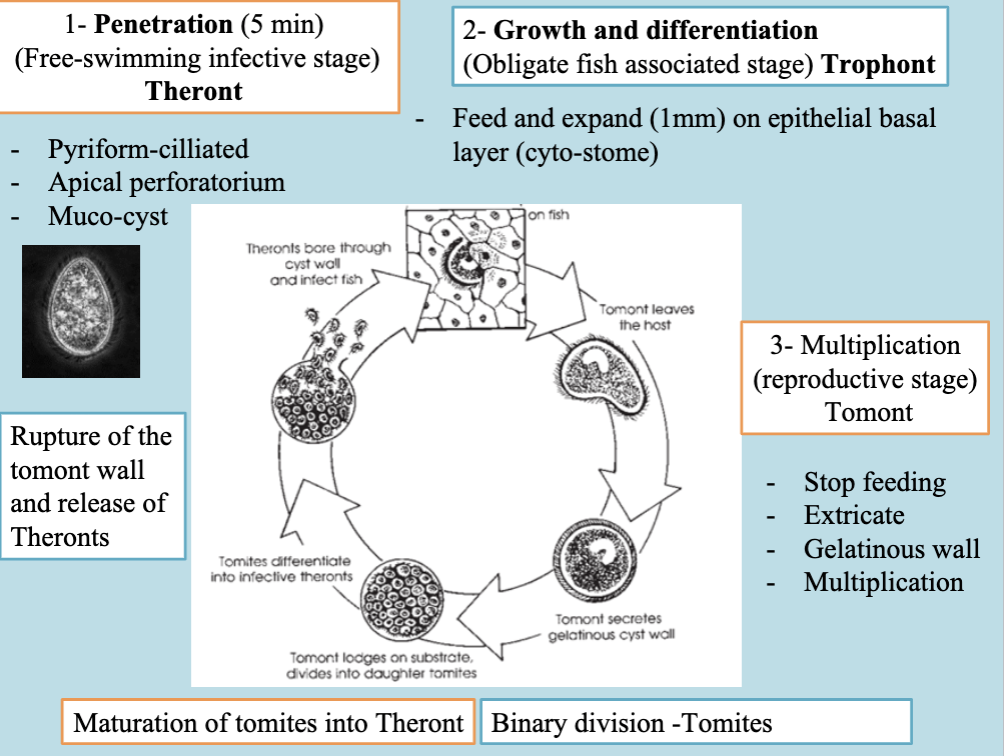
70
New cards
Slime Disease in fish
- Caused by parasites “Chilodonella” that attach to the skin causing severe irritation and – fish produces large amounts of slime or mucus in response to the irritation.
- Genus Chilodonella include several organism, can infect fresh, brackish and marine water fishes
Clinical and behavioral signs:
1- Increase secretion of mucus, with an overall slimy, patchy or mottled grey appearance.
2- These films of mucus and cellular debris may become detached from the skin surface leaving skin ulcer .
3- The fish is not schooling (isolate itself), or resting on the bottom
4- Rubbing and scratching against objects due to skin irritation.
5- Anorexia > Emaciation and death
- Infection of gills will results in signs of hypoxia; Rapid breathing (mouth opening and movement of the operculum), swimming on surface or near aerator.
Treatment:
- Raising water temperature to 86 Fahrenheit, add aquarium salt at a dose of 0.4 to 0.7 ounce per gallon.
- Warm, saline conditions should be maintained for 7 to 14 days.
- If salt solution does not work, use a formalin, Potassium Permanganate bath, cupper sulfate, or 2% salt solution bath for up to 7 days.
- Isolate the infected fish
- Genus Chilodonella include several organism, can infect fresh, brackish and marine water fishes
Clinical and behavioral signs:
1- Increase secretion of mucus, with an overall slimy, patchy or mottled grey appearance.
2- These films of mucus and cellular debris may become detached from the skin surface leaving skin ulcer .
3- The fish is not schooling (isolate itself), or resting on the bottom
4- Rubbing and scratching against objects due to skin irritation.
5- Anorexia > Emaciation and death
- Infection of gills will results in signs of hypoxia; Rapid breathing (mouth opening and movement of the operculum), swimming on surface or near aerator.
Treatment:
- Raising water temperature to 86 Fahrenheit, add aquarium salt at a dose of 0.4 to 0.7 ounce per gallon.
- Warm, saline conditions should be maintained for 7 to 14 days.
- If salt solution does not work, use a formalin, Potassium Permanganate bath, cupper sulfate, or 2% salt solution bath for up to 7 days.
- Isolate the infected fish
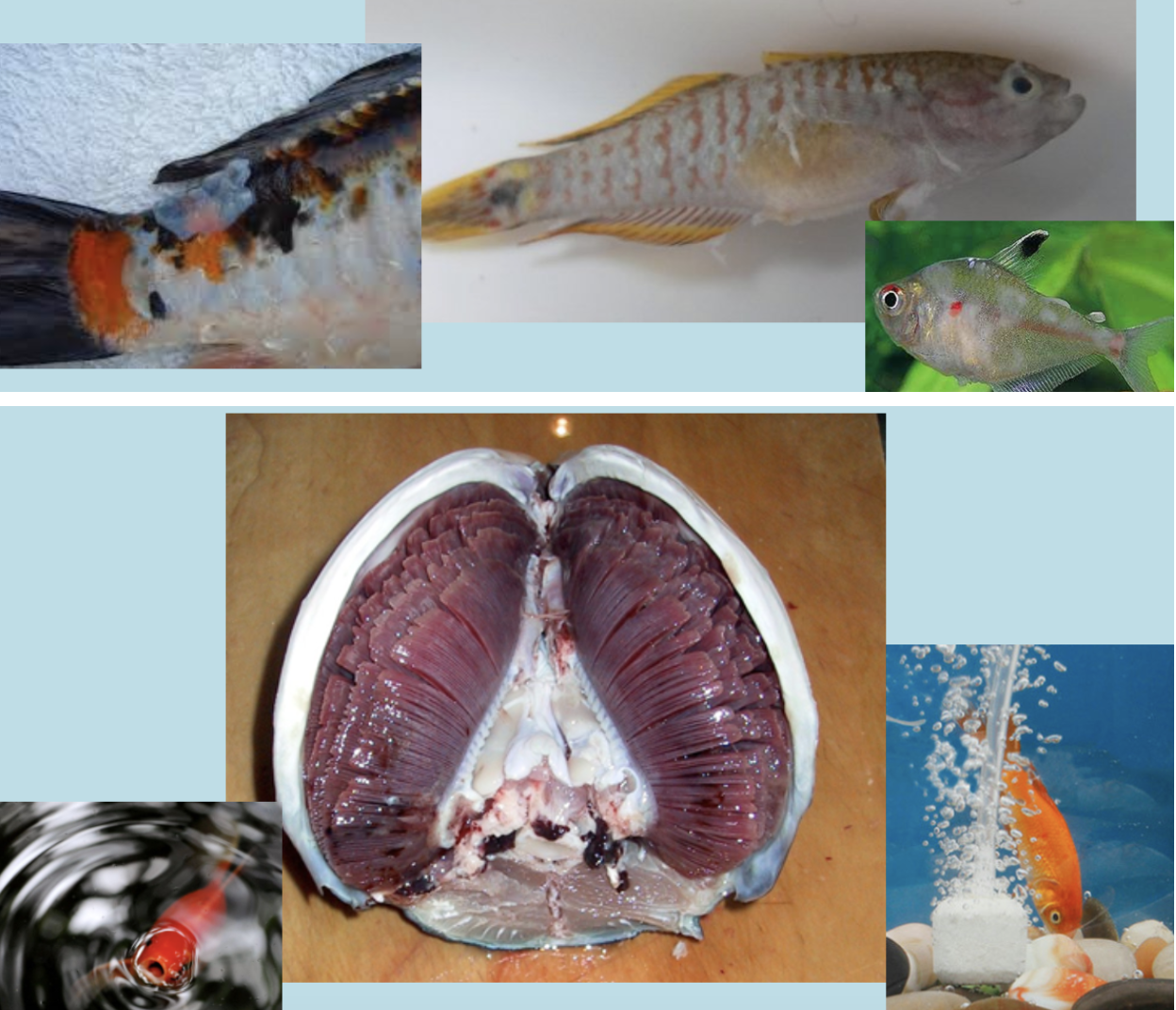
71
New cards
Fish Flukes (Gill Flukes)
- Dactylogyrus (Gill flukes) which attach to the gills and vary from 0.5
to 3.00 mm long ( Attach by tiny hooks and have a sucking mouth)
- It everts its pharynx through the mouth and releases a digestive
solution with proteolytic enzymes (digest and liquefy tissue
proteins) which dissolves fish tissue >> Mucous and dissolved tissue
are then sucked into the gut.
Clinical and behavioral signs:
- Hypoxia or suffocation (reduced O2 level in the blood) and fast-
moving gills, swim at the surface or near the aerator stone, and pant
heavily trying to get more O2.
- Death due hyperplasia, swelling and edema of the gills tissue which
interfere with oxygen exchange (Suffocation and hypoxia)
Diagnosis: Detect the flukes or inflammation of gill filaments
Treatment :
- Raising water temperature to 86 Fahrenheit, add aquarium salt
- With salt, Malachite green, Methylene blue or formalin baths.
to 3.00 mm long ( Attach by tiny hooks and have a sucking mouth)
- It everts its pharynx through the mouth and releases a digestive
solution with proteolytic enzymes (digest and liquefy tissue
proteins) which dissolves fish tissue >> Mucous and dissolved tissue
are then sucked into the gut.
Clinical and behavioral signs:
- Hypoxia or suffocation (reduced O2 level in the blood) and fast-
moving gills, swim at the surface or near the aerator stone, and pant
heavily trying to get more O2.
- Death due hyperplasia, swelling and edema of the gills tissue which
interfere with oxygen exchange (Suffocation and hypoxia)
Diagnosis: Detect the flukes or inflammation of gill filaments
Treatment :
- Raising water temperature to 86 Fahrenheit, add aquarium salt
- With salt, Malachite green, Methylene blue or formalin baths.
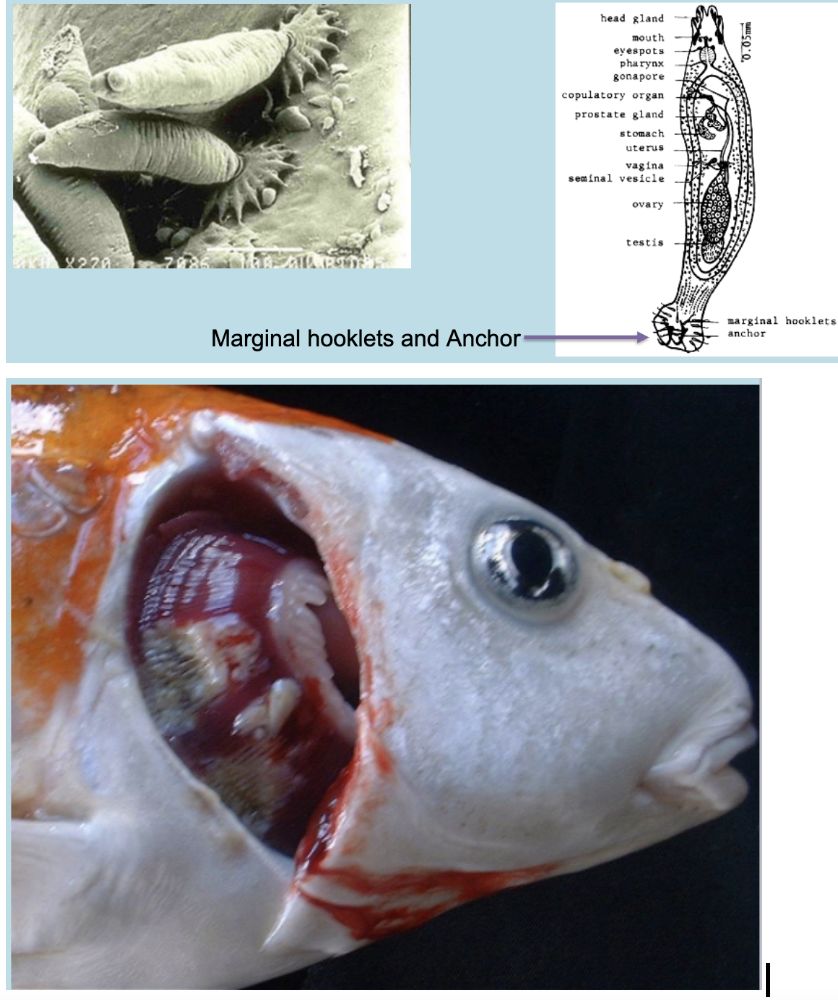
72
New cards
Fish Flukes (Skin Flukes)
- Gyrodactylus (Skin flukes) which attach themselves to the body of
the fish, can reach up to 5 mm in size seen by naked eye.
- It causes severe skin irritation, fishes perform severe rubbing and scratching against objects due to skin irritation.
- This leads to slime production in response to the irritation and may lead to detached skin, leaving ulcers that might lead to secondary bacterial, fungal or viral infection.
Diagnosis; can be seen by naked eyes or using a magnifying lens
Treatment;
- Removal by curved tip tweezers
- Raising water temperature to 86 F, add aquarium salt
- With salt, Malachite green and Methylene blue and formalin baths.
the fish, can reach up to 5 mm in size seen by naked eye.
- It causes severe skin irritation, fishes perform severe rubbing and scratching against objects due to skin irritation.
- This leads to slime production in response to the irritation and may lead to detached skin, leaving ulcers that might lead to secondary bacterial, fungal or viral infection.
Diagnosis; can be seen by naked eyes or using a magnifying lens
Treatment;
- Removal by curved tip tweezers
- Raising water temperature to 86 F, add aquarium salt
- With salt, Malachite green and Methylene blue and formalin baths.
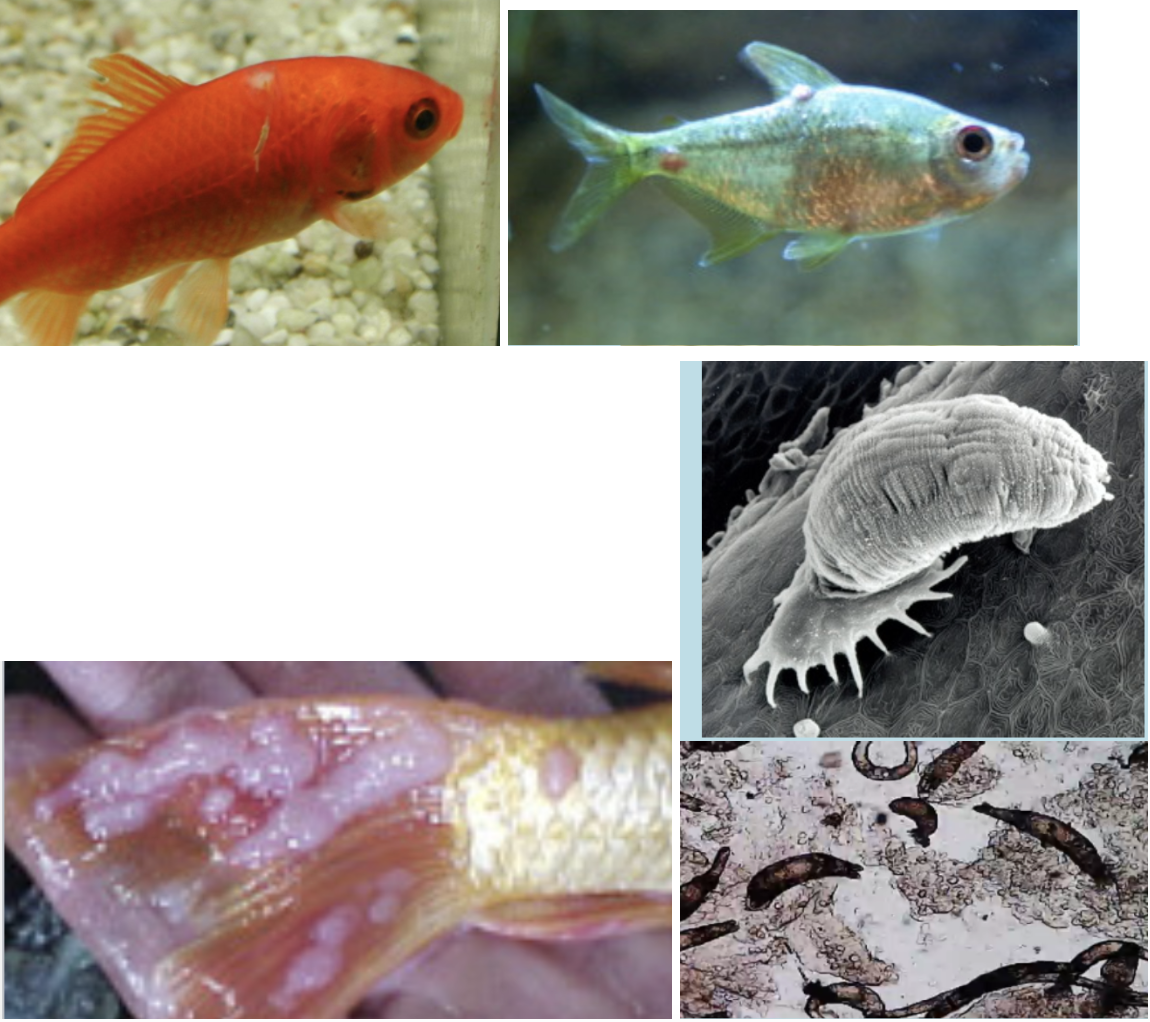
73
New cards
Hole in the head disease
- Occasionally caused by Hexamita (flagellated protozoa).
- The organism lives peacefully in the intestinal tract but when the fish immunity falls down, it then migrates to internal organs, skin, and muscle tissue.
- The organism multiplies, it destroys tissue causing necrosis (tissue death).
- The decayed tissue breaks away leaving holes in the body
- Which leads to secondary bacterial or viral infection and death.
- Lesions are most common around the head and lateral line.
Another theory suggested that:
- Lack of minerals (Ca, Ph) and vitamins (C, D) from poor nutrition, and the use of activated charcoal stimulate the organism
- Stress due to poor water quality and aggression.
Mainly a problem on cichlids, angel fish, and discus fish.
Remove the underlying problem!
- Treatment by Metronidazole (Antiprotozoal and antibiotic) added to water as treatment + Mineral and Vitamin supplements
- The organism lives peacefully in the intestinal tract but when the fish immunity falls down, it then migrates to internal organs, skin, and muscle tissue.
- The organism multiplies, it destroys tissue causing necrosis (tissue death).
- The decayed tissue breaks away leaving holes in the body
- Which leads to secondary bacterial or viral infection and death.
- Lesions are most common around the head and lateral line.
Another theory suggested that:
- Lack of minerals (Ca, Ph) and vitamins (C, D) from poor nutrition, and the use of activated charcoal stimulate the organism
- Stress due to poor water quality and aggression.
Mainly a problem on cichlids, angel fish, and discus fish.
Remove the underlying problem!
- Treatment by Metronidazole (Antiprotozoal and antibiotic) added to water as treatment + Mineral and Vitamin supplements
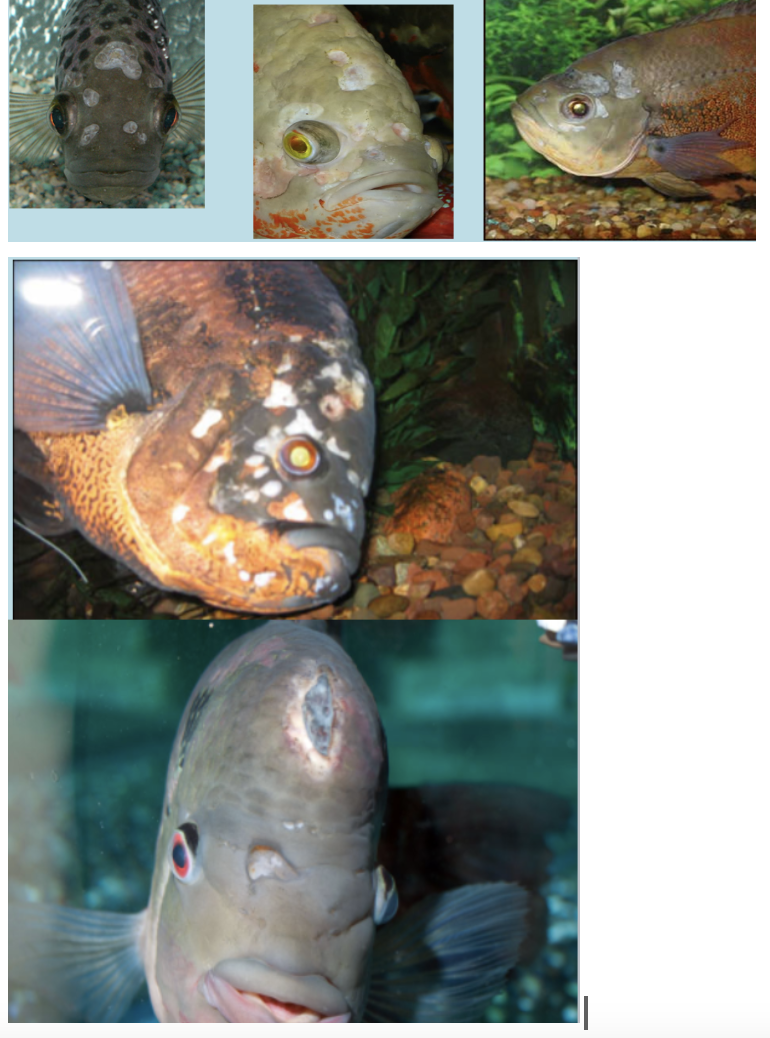
74
New cards
Fungal Infections (Cotton Wool Disease)
- Fungi spores (opportunistic M.O.) are present throughout most aquariums, but only under certain conditions they will flourish up and causing clinical infection:
Predisposing factors (underlying problems)
1- Poor water quality: PH, salinity, turbidity, hardness.
2- Poor hygiene such as - dead fish OR Large amounts of decomposing organic material in the tank (high levels of ammonia or nitrites)
3- Overstocking, irregular temperature and/or oxygen distribution
4- Fish that are injured (bullying by other fishes), old, or have other diseases (stressed)
5- Improper nutrition: Vitamin or mineral deficiency
6- Always occurs as a secondary infection after another disease.
- Caused by Saprolegnia fungus organism
- It appears as a cotton-like substance concentrated mainly on surface injuries of the body or fins
- Lesions will lead to stress and irritation > anorexia, hypoxia and death.
- Secondary bacterial or viral infections are common
Treatment: remove the underlying problem!
- May have to scratch off the affected tissue and treat wound with iodine.
- Improve water quality and raise water temperature to 86 Fahrenheit, add aquarium salt
- Use antifungal along with antibacterial to prevent secondary bacterial infection
Predisposing factors (underlying problems)
1- Poor water quality: PH, salinity, turbidity, hardness.
2- Poor hygiene such as - dead fish OR Large amounts of decomposing organic material in the tank (high levels of ammonia or nitrites)
3- Overstocking, irregular temperature and/or oxygen distribution
4- Fish that are injured (bullying by other fishes), old, or have other diseases (stressed)
5- Improper nutrition: Vitamin or mineral deficiency
6- Always occurs as a secondary infection after another disease.
- Caused by Saprolegnia fungus organism
- It appears as a cotton-like substance concentrated mainly on surface injuries of the body or fins
- Lesions will lead to stress and irritation > anorexia, hypoxia and death.
- Secondary bacterial or viral infections are common
Treatment: remove the underlying problem!
- May have to scratch off the affected tissue and treat wound with iodine.
- Improve water quality and raise water temperature to 86 Fahrenheit, add aquarium salt
- Use antifungal along with antibacterial to prevent secondary bacterial infection
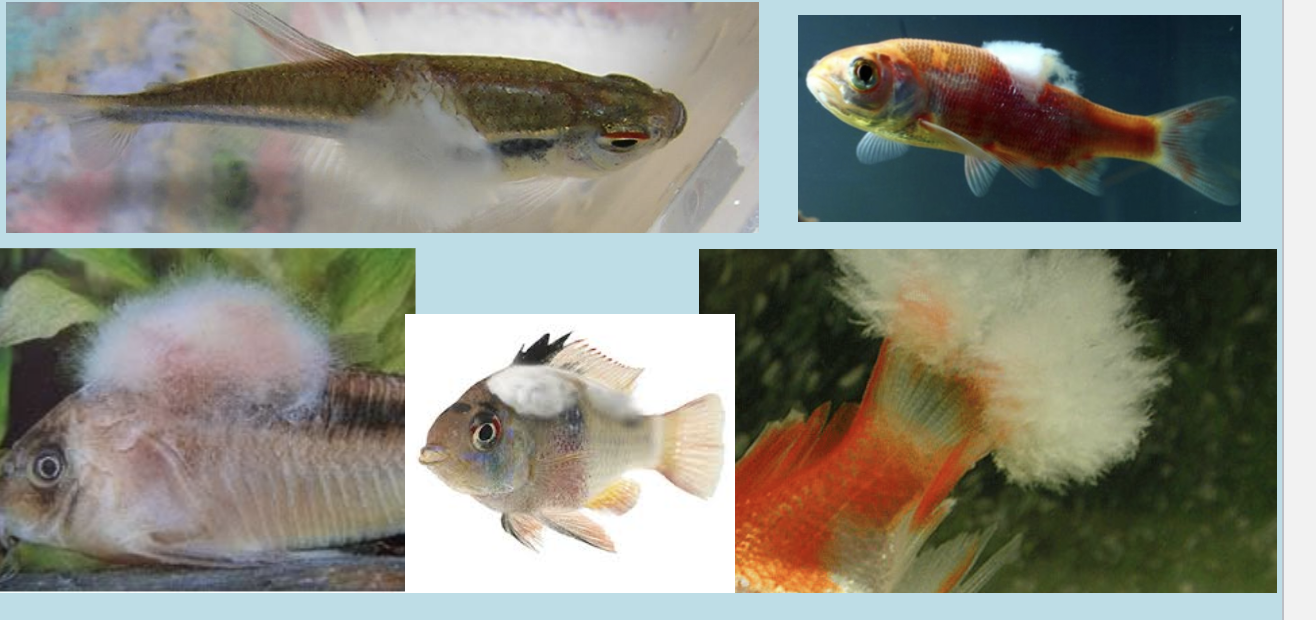
75
New cards
Fin rot
- Fin rot is usually a bacterial disease involving opportunistic bacteria such as Aeromonas, Pseudomonas or Flexibacter that around in all aquatic
environments.
Predisposing factors (underlying problems):
1- Poor water quality: PH, salinity, turbidity, hardness.
2- Poor hygiene such as dead fish or large amounts of decomposing organic material in the tank (high levels of ammonia or nitrites)
3- Overstocking, irregular temperature and/or oxygen distribution
4- Fish that are injured (bullying by other fishes), old, or have other diseases (stressed)
5- Improper nutrition: Vitamin or mineral deficiency
6- Fin nipping by other fish: Fish fin injury
- It results in necrotic loss of fin tissue, resulting in split or ragged fins. (bottom photos)
- It is usually the edge of the fin that is attacked.
- Occasionally a hole may appear in the middle of the fin.
- Secondary fungal infections are very common
- In bacterial fin rot the edge of the lesion is usually inflamed and red in color unlike when a secondary fungal infection occurs, it shows the opaque or whitish color at edges (top four photos)
Treatment: remove the underlying problem!
- May have to trim off necrotic tissue with sterile curved scissors and treat wound with iodine.
- Commercially available antibiotic (i.e., Erythromycin) and antifungal water treatments.
environments.
Predisposing factors (underlying problems):
1- Poor water quality: PH, salinity, turbidity, hardness.
2- Poor hygiene such as dead fish or large amounts of decomposing organic material in the tank (high levels of ammonia or nitrites)
3- Overstocking, irregular temperature and/or oxygen distribution
4- Fish that are injured (bullying by other fishes), old, or have other diseases (stressed)
5- Improper nutrition: Vitamin or mineral deficiency
6- Fin nipping by other fish: Fish fin injury
- It results in necrotic loss of fin tissue, resulting in split or ragged fins. (bottom photos)
- It is usually the edge of the fin that is attacked.
- Occasionally a hole may appear in the middle of the fin.
- Secondary fungal infections are very common
- In bacterial fin rot the edge of the lesion is usually inflamed and red in color unlike when a secondary fungal infection occurs, it shows the opaque or whitish color at edges (top four photos)
Treatment: remove the underlying problem!
- May have to trim off necrotic tissue with sterile curved scissors and treat wound with iodine.
- Commercially available antibiotic (i.e., Erythromycin) and antifungal water treatments.
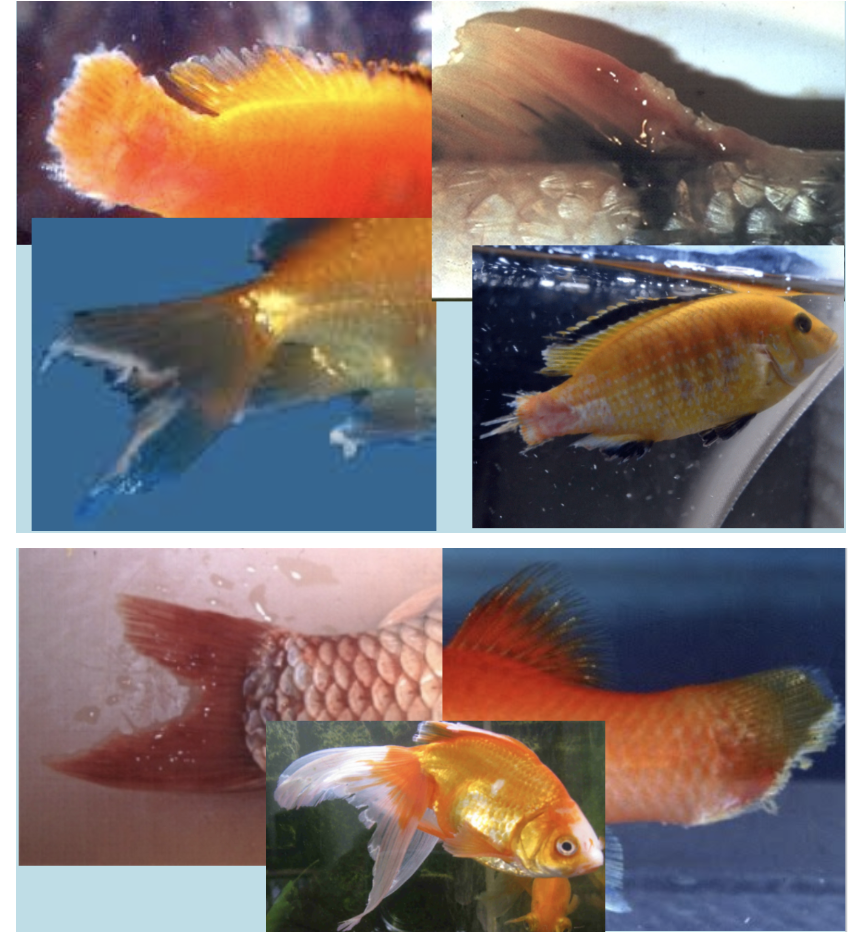
76
New cards
Mouth Fungus (cotton-mouth disease)
- Name is incorrect as this is actually a gram-negative rod bacterial disease, called Columnaris bacteria (several spp.)
- It will typically attach themselves to a fish's head, mouth, lips, or inside the mouth (cotton mouth) or body (Saddleback)
1- Cotton mouth:
Fish usually dies mainly due to starvation
- Starts with redness and inflammation and then turn into cotton like substance, commonly called cotton-mouth because the fish's mouth seems to be covered with a thread-like cottonish substance.
2- Saddleback:
- Columnaris can also appear as yellowish-brown, white, or grayish-white spots on some part of the body which are usually surrounded by a cottony a lesion (BIG ULCER).
- Ulcerations develop within 24 to 48 hours.
- Fatality occurs between 48 and 72 hours
Treatment: A medicated fish bath (using methylene blue or potassium permanganate and salt) and antibiotic (i.e., Kanamycin) for several days.
- It will typically attach themselves to a fish's head, mouth, lips, or inside the mouth (cotton mouth) or body (Saddleback)
1- Cotton mouth:
Fish usually dies mainly due to starvation
- Starts with redness and inflammation and then turn into cotton like substance, commonly called cotton-mouth because the fish's mouth seems to be covered with a thread-like cottonish substance.
2- Saddleback:
- Columnaris can also appear as yellowish-brown, white, or grayish-white spots on some part of the body which are usually surrounded by a cottony a lesion (BIG ULCER).
- Ulcerations develop within 24 to 48 hours.
- Fatality occurs between 48 and 72 hours
Treatment: A medicated fish bath (using methylene blue or potassium permanganate and salt) and antibiotic (i.e., Kanamycin) for several days.

77
New cards
Zoonosis
They are infectious diseases of vertebrate animals, that can be transmitted to humans and cause severe illness (- WHO 1959)
Zoon: Animal
Noson: Transmissible disease
Zoon: Animal
Noson: Transmissible disease
78
New cards
Background on Zoonotic Diseases
1- There are around 1,407 human common pathogens known to infect humans and cause severe illness, about 61% are zoonotic.
2- Moreover around 70% of emerging diseases are zoonotic (Ex. Ebola virus, SARS, Salmonellosis, Influenza (bird and swine), plague, BSE .....).
3- Most of the human diseases originated primarily in animals, HIV; originated in animals and was a zoonotic disease transmitted to humans in early 20th century.
However, those diseases that involve animals to human
transmission (Directly or indirectly) are called zoonotic diseases.
2- Moreover around 70% of emerging diseases are zoonotic (Ex. Ebola virus, SARS, Salmonellosis, Influenza (bird and swine), plague, BSE .....).
3- Most of the human diseases originated primarily in animals, HIV; originated in animals and was a zoonotic disease transmitted to humans in early 20th century.
However, those diseases that involve animals to human
transmission (Directly or indirectly) are called zoonotic diseases.
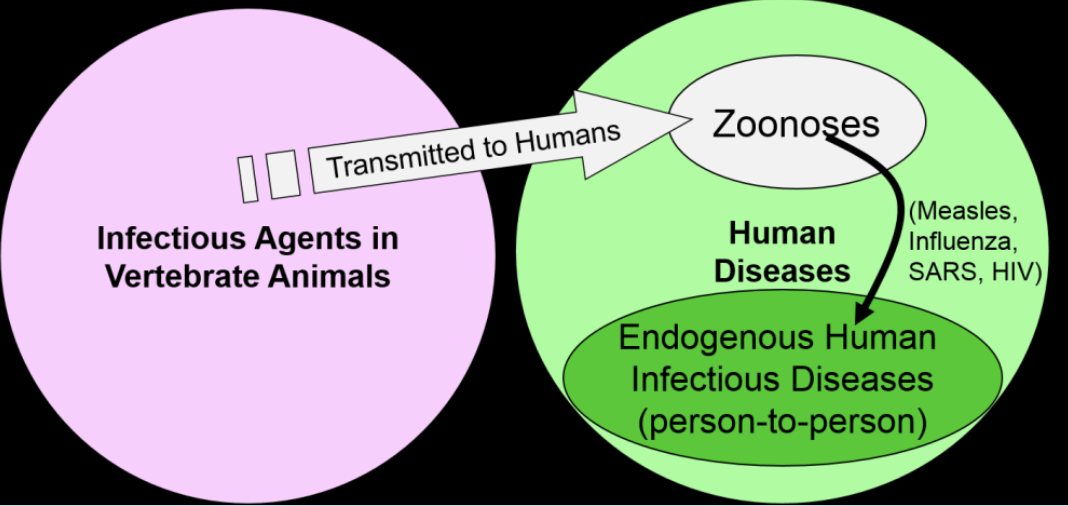
79
New cards
Zoonotic diseases
Over than 200 zoonotic diseases were fully identified, most of them are highly infectious, causing severe illness and may lead to death.
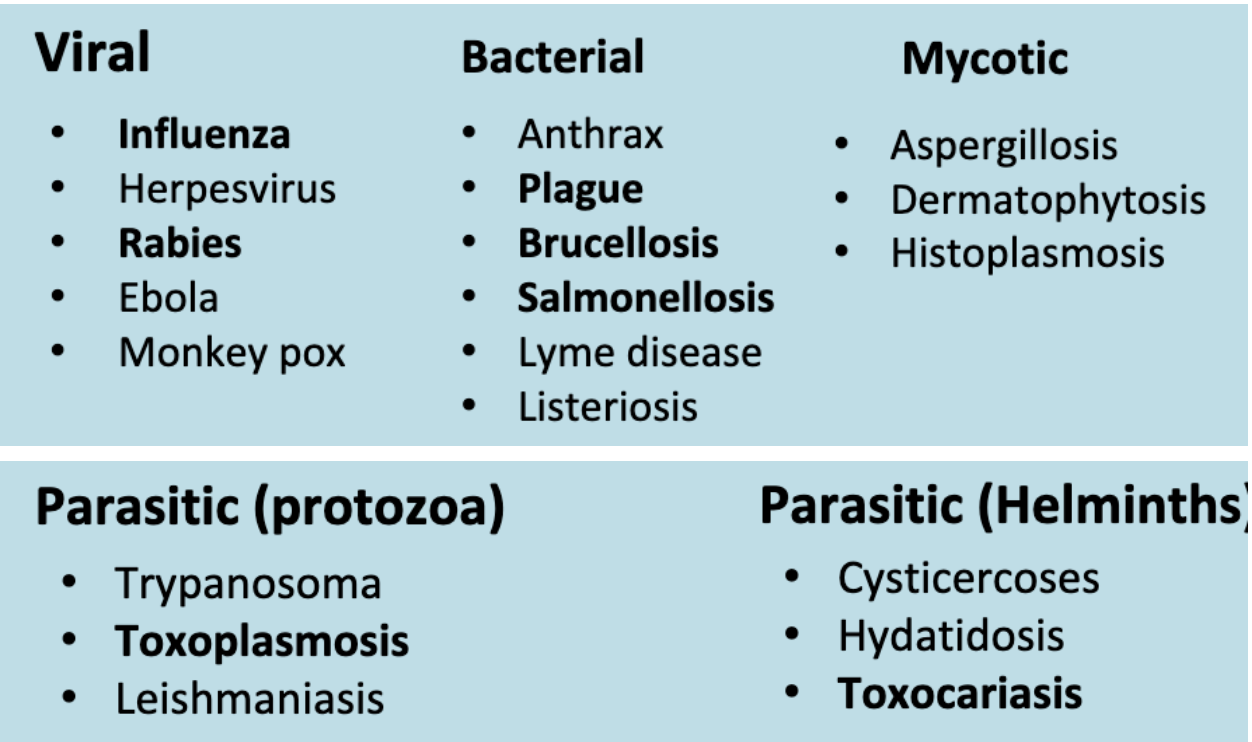
80
New cards
Transmission of Zoonotic Diseases
- Transmission of Zoonotic disease (Contagious) might occur through direct (direct contact with the animal) or indirect contact (contact with contaminated animal’s fomite; cage, litter, food, water, dropping...).
1- Aerosol transmission; Occurs when droplets are passed through the air from an infected animal and are breathed in by a person. Ex. Nasal droplets: microscopic particles of respiratory droplets that carried through air in Influenza
2- Oral transmission; Occurs by ingesting food or water contaminated with a pathogen from animals. Ex. Eating or drinking after handling animals without washing your hands could also lead to oral zoonotic disease transmission; Salmonellosis.
3- Invasive transmission; Occurs when infected droplets from the animal directly touches open wound in the skin or mucous membranes.Ex. Contaminated saliva touches open skin wound or mucous membranes (Animal bites) can transmit Rabies????
4- Fomite transmission; A fomite is an inanimate (non-living) object that can carry a pathogen from an animal to a person. Ex. Clothing, bedding cage, litter, food, water, dropping...
5- Vector transmission; Occurs when an insect acquires a pathogen from one animal and transmits it to a person: think mosquitoes
1- Aerosol transmission; Occurs when droplets are passed through the air from an infected animal and are breathed in by a person. Ex. Nasal droplets: microscopic particles of respiratory droplets that carried through air in Influenza
2- Oral transmission; Occurs by ingesting food or water contaminated with a pathogen from animals. Ex. Eating or drinking after handling animals without washing your hands could also lead to oral zoonotic disease transmission; Salmonellosis.
3- Invasive transmission; Occurs when infected droplets from the animal directly touches open wound in the skin or mucous membranes.Ex. Contaminated saliva touches open skin wound or mucous membranes (Animal bites) can transmit Rabies????
4- Fomite transmission; A fomite is an inanimate (non-living) object that can carry a pathogen from an animal to a person. Ex. Clothing, bedding cage, litter, food, water, dropping...
5- Vector transmission; Occurs when an insect acquires a pathogen from one animal and transmits it to a person: think mosquitoes
81
New cards
Risk of zoonotic diseases transmission from companion animals
1- The host dynamic relationship between companion animal/human and the surrounding environment. (we are breathing the same air, sharing beds, food, etc., )
2- The fact that most of the companion animals are asymptomatic ( Show no clinical signs) for most of the zoonotic diseases
- Ex. Dogs (Reptiles, Fish) that are positive to salmonellosis, are usually showing no signs of illness while they are shedding pathogen and contaminating the environment (Carrier - Reservoir).
3- Some faulty habits such as; Improper handling of pets (allowing pets kissing and licking), improper hand hygiene (washing hand after handling a pet and before eating), disposing of pet waste and water in kitchen sinks might result in contamination of food and kitchen surfaces.
4- Improper pet management; feeding pets raw food diet or pet treats made from animal parts (raw meat, egg, unpasteurized milk, animals hides: Cysticercoses, Hydatid, Salmonellosis).
5- Absence of regular screening for diseases.
6- Extreme contact with wildlife.
7- Lack of knowledge about the importance and the great danger of zoonotic diseases.
2- The fact that most of the companion animals are asymptomatic ( Show no clinical signs) for most of the zoonotic diseases
- Ex. Dogs (Reptiles, Fish) that are positive to salmonellosis, are usually showing no signs of illness while they are shedding pathogen and contaminating the environment (Carrier - Reservoir).
3- Some faulty habits such as; Improper handling of pets (allowing pets kissing and licking), improper hand hygiene (washing hand after handling a pet and before eating), disposing of pet waste and water in kitchen sinks might result in contamination of food and kitchen surfaces.
4- Improper pet management; feeding pets raw food diet or pet treats made from animal parts (raw meat, egg, unpasteurized milk, animals hides: Cysticercoses, Hydatid, Salmonellosis).
5- Absence of regular screening for diseases.
6- Extreme contact with wildlife.
7- Lack of knowledge about the importance and the great danger of zoonotic diseases.
82
New cards
Population at risk of zoonotic diseases
Children less than 5 years old, immunocompromised individuals (Individuals suffer from immune disorder, individuals uptake immunosuppressant medications, chemotherapy and overstressed individuals), elderly and pregnant women are at the greatest risk.
83
New cards
Salmonellosis: What is it?
Caused by a bacteria called Salmonella mainly 2 types (Typhimurium and Enteritidis) are the most common types in the United States, more common in the summer than in the winter for risky individuals (Young children, elderly, impaired immunity...., however)
It is estimated that there are approximately 1.4 million cases of Salmonella Infections, including 400 deaths in the U.S. annually (CDC, 2017 )
It is estimated that there are approximately 1.4 million cases of Salmonella Infections, including 400 deaths in the U.S. annually (CDC, 2017 )
84
New cards
Salmonellosis: How Do I get it?
Ingestion of contaminated food with pathogens; Infection mostly
happens due to improper hand hygiene after contact with infected
or carrier animals or their fomites.
Some animals might show clinical signs such as diarrhea while most of the animals do not show any clinical signs but still able to shed bacteria and contaminate the environment.
Reptiles (snakes and particularly turtles), most of the birds particularly baby chicks, fresh water aquarium, and small rodents are usually carriers and will never show clinical signs.
Dogs, cats, rabbits and other small companion animals might be positive and transmit infection without showing signs as well.
happens due to improper hand hygiene after contact with infected
or carrier animals or their fomites.
Some animals might show clinical signs such as diarrhea while most of the animals do not show any clinical signs but still able to shed bacteria and contaminate the environment.
Reptiles (snakes and particularly turtles), most of the birds particularly baby chicks, fresh water aquarium, and small rodents are usually carriers and will never show clinical signs.
Dogs, cats, rabbits and other small companion animals might be positive and transmit infection without showing signs as well.
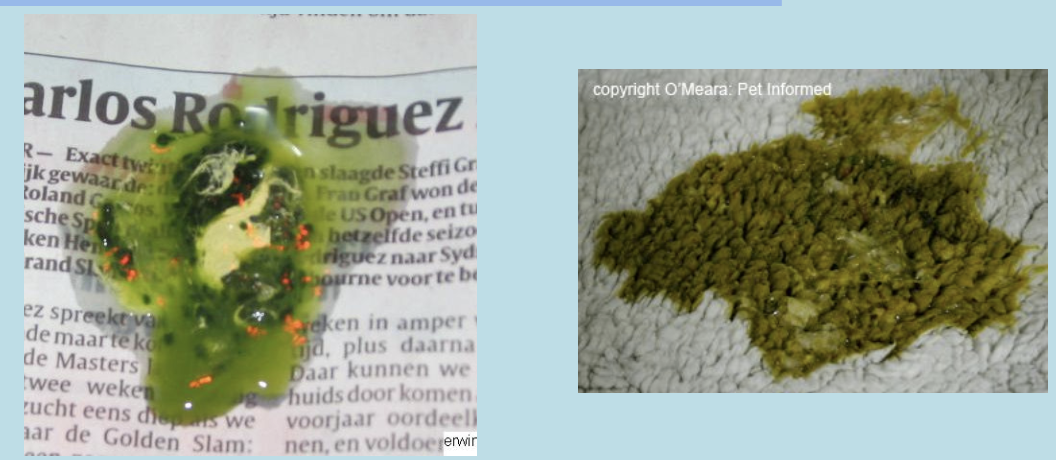
85
New cards
Salmonellosis: What are the symptoms?
Symptoms of salmonellosis include;
1. Fever
2. Severe diarrhea
3. Severe abdominal cramps
4. They develop 12 to 72 hours after infection, and the illness usually lasts 4 to 7 days.
- Adult and healthy individuals might recover without treatment, while risky individuals are at highest risk.
- Dehydration is the most common complication and might lead to death.
5. A small number of people who are infected with salmonellosis
develop reactive arthritis, a disease that can last for months or years
and can lead to chronic arthritis.
1. Fever
2. Severe diarrhea
3. Severe abdominal cramps
4. They develop 12 to 72 hours after infection, and the illness usually lasts 4 to 7 days.
- Adult and healthy individuals might recover without treatment, while risky individuals are at highest risk.
- Dehydration is the most common complication and might lead to death.
5. A small number of people who are infected with salmonellosis
develop reactive arthritis, a disease that can last for months or years
and can lead to chronic arthritis.
86
New cards
Cat Scratch Disease: What is it?
Cat scratch disease (CSD) is a bacterial disease caused by Bartonella spp.
- About 40% of cats carry Bartonella at some time in their lives.
- Infected cats that carry with Bartonella do not show any signs of illness; therefore, you cannot tell which cats can spread the disease to you.
- Kittens are more likely to be infected and to pass the bacterium to people.
- About 40% of cats carry Bartonella at some time in their lives.
- Infected cats that carry with Bartonella do not show any signs of illness; therefore, you cannot tell which cats can spread the disease to you.
- Kittens are more likely to be infected and to pass the bacterium to people.
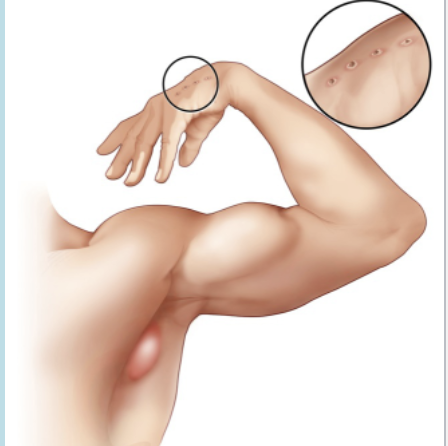
87
New cards
Cat Scratch Disease: How Do I get it?
- Most people with CSD have been bitten or scratched by a cat.
- Flea
- Flea
88
New cards
Cat Scratch Disease: What are the symptoms in humans?
- Mild infection at the point of injury, lymph nodes, especially those
around the head, neck, and upper limbs, become swollen.
- Fever, headache, fatigue, and a poor appetite for about a week.
- Rare complications of Bartonella infection are bacillary angiomatosis (reddish elevated lesions often surrounded by a scaly ring) and or severe eye lesion in case of eye infection.
around the head, neck, and upper limbs, become swollen.
- Fever, headache, fatigue, and a poor appetite for about a week.
- Rare complications of Bartonella infection are bacillary angiomatosis (reddish elevated lesions often surrounded by a scaly ring) and or severe eye lesion in case of eye infection.
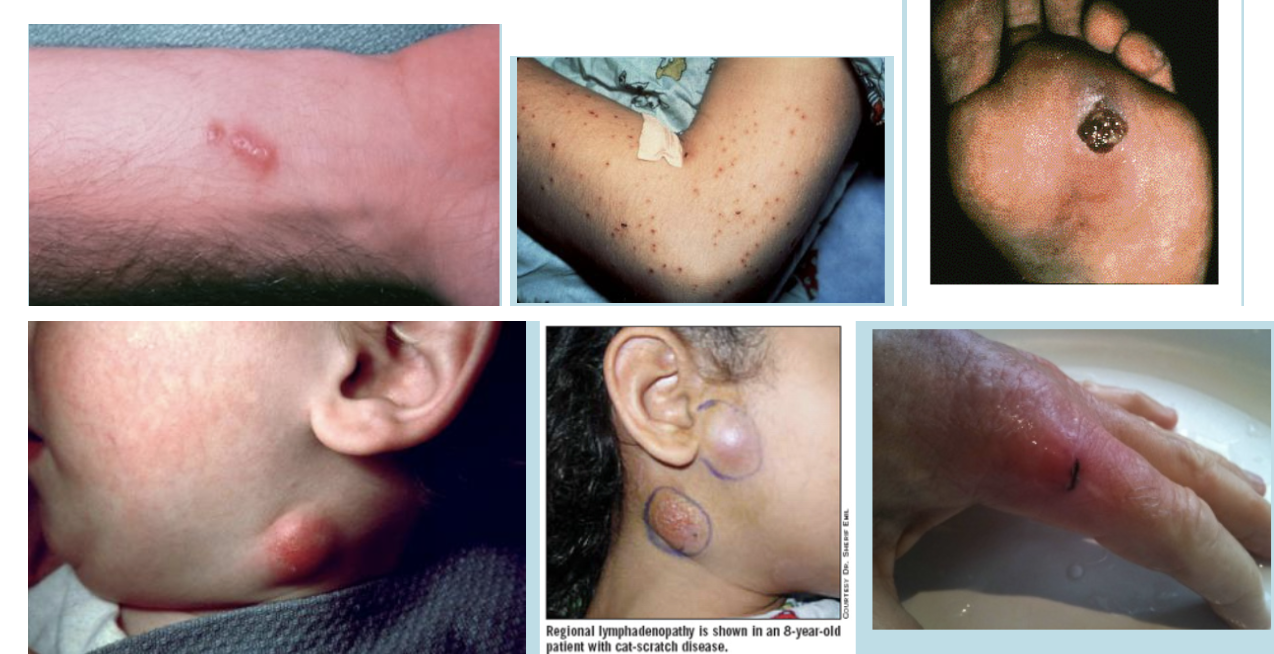
89
New cards
Ringworm: What is it?
- Ringworm is a skin infection caused by a fungus dermatophytosis.
- Ringworm can affect skin on your body (tinea corporis), scalp (tinea capitis), groin area (tinea cruris), or feet (tinea pedis, also called athlete's foot).
- Ringworm can affect skin on your body (tinea corporis), scalp (tinea capitis), groin area (tinea cruris), or feet (tinea pedis, also called athlete's foot).
90
New cards
Ringworm: How do I get it?
- Ringworm is contagious. It can be passed from one person to the next by direct skin-to-skin contact or by contact with contaminated items such as combs, unwashed clothing, and shower or pool surfaces.
- You can also catch ringworm from pets that carry the fungus. Dogs, Cats and Rabbits are common carriers.
- Many different kinds of animals can transmit ringworm to people; Dogs and cats, especially kittens or puppies, can have ringworm that can be passed to people.
- Other animals such as rabbits, guinea pigs, ferrets can pass ringworm to people too.
- You can also catch ringworm from pets that carry the fungus. Dogs, Cats and Rabbits are common carriers.
- Many different kinds of animals can transmit ringworm to people; Dogs and cats, especially kittens or puppies, can have ringworm that can be passed to people.
- Other animals such as rabbits, guinea pigs, ferrets can pass ringworm to people too.
91
New cards
Ringworm: Risk factors for Ringworm
Age: young and senior animals have weaker immune systems that
aren’t as naturally resistant to fungi.
Environment: Being in a group animal setting such as a shelter, pet
store, or kennel increases a dog’s chance of being exposed to infected
animals.
Medical conditions and medications: Some ongoing medical
problems and medications can lower the immune system’s ability to
fight off germs.
Behavior: animals i.e., Dogs that like to dig are more likely to come into
contact with fungi spores (microscopic seeds) in the dirt.
Breed: some breeds i.e., in dogs Boston terriers, Yorkshire terriers, and Jack Russell terriers are more susceptible to ringworm infection.
aren’t as naturally resistant to fungi.
Environment: Being in a group animal setting such as a shelter, pet
store, or kennel increases a dog’s chance of being exposed to infected
animals.
Medical conditions and medications: Some ongoing medical
problems and medications can lower the immune system’s ability to
fight off germs.
Behavior: animals i.e., Dogs that like to dig are more likely to come into
contact with fungi spores (microscopic seeds) in the dirt.
Breed: some breeds i.e., in dogs Boston terriers, Yorkshire terriers, and Jack Russell terriers are more susceptible to ringworm infection.
92
New cards
Ringworm: What are the symptoms in animals?
- Poor hair coat with irritated and reddened skin (erythema); darkened skin (hyperpigmentation); Not itchy BUT - itchiness (pruritus); and hair loss (alopecia), which may be patchy or circular (diffused). The classic sign of circular hair loss is most commonly seen in cats.
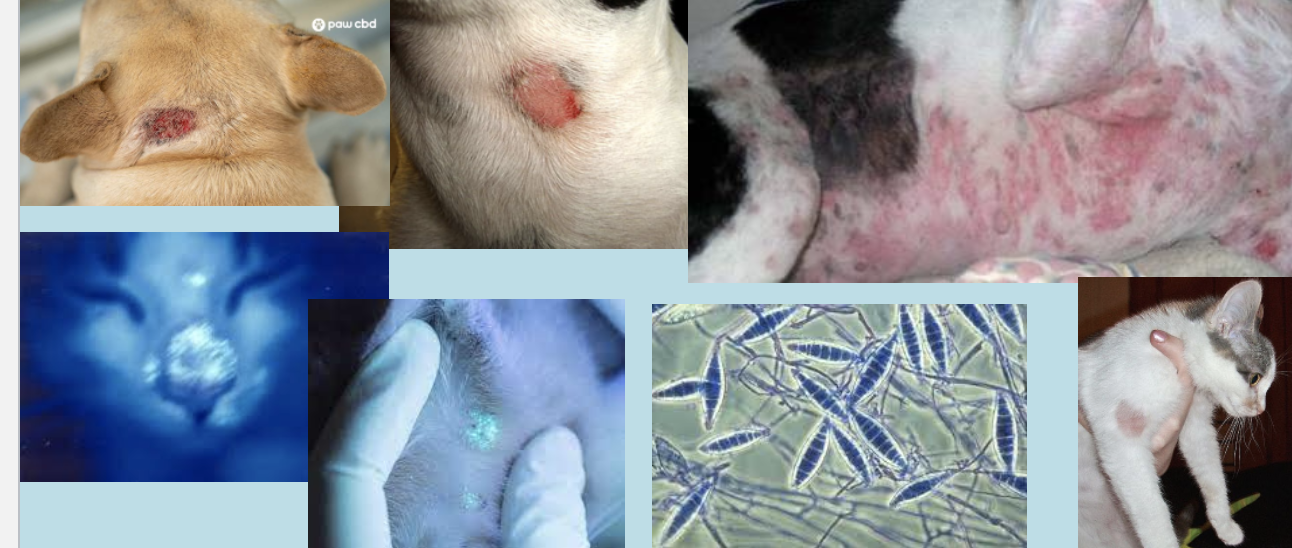
93
New cards
Ringworm: Prevention and Treatment in Animals
• Eventually, ringworm usually goes away on its own, BUT.......
• Home Remedies & Veterinary Treatment (change the pH, antifungal ointment, shampoo, oral antifungal + antibiotic ointment if complicated with bacteria) + Immune system! last several weeks or months
• Prevent ringworm from spreading to other pets or reinfecting your dog (Ringworm spores are easily spread through shed hair and skin cells, and can live on surfaces for years unless you disinfect them; Bedding, Clothing, Carpet, Grooming tools, Furniture, Food and water bowls, Pet carrier and toys
• Minimize outdoor, and interaction time with your pet
• Home Remedies & Veterinary Treatment (change the pH, antifungal ointment, shampoo, oral antifungal + antibiotic ointment if complicated with bacteria) + Immune system! last several weeks or months
• Prevent ringworm from spreading to other pets or reinfecting your dog (Ringworm spores are easily spread through shed hair and skin cells, and can live on surfaces for years unless you disinfect them; Bedding, Clothing, Carpet, Grooming tools, Furniture, Food and water bowls, Pet carrier and toys
• Minimize outdoor, and interaction time with your pet
94
New cards
Ringworm: What are the symptoms in humans?
- Itchy, red, raised, scaly patches that may blister and ooze. - The patches often have sharply-defined edges, they are often redder around the outside with normal skin tone in the center (This may create the appearance of a ring)- When your scalp or beard is infected, you will have bald patches.- If nails are infected, they become discolored, thick, and even crumble.
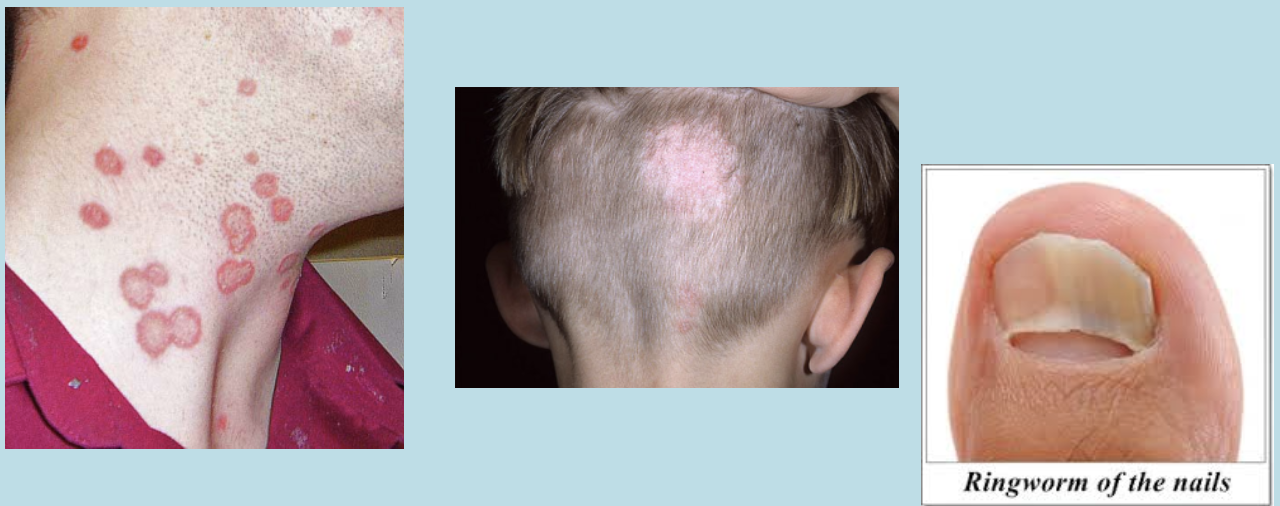
95
New cards
Sarcoptic Mange: What is it?
- Microscopic Sarcoptic mange – burrowing mites cause sarcoptic mange, also known as scabies.
- These mites will burrow through the skin causing intense itching and irritation.
- The scratching that results from mange is what causes the majority of the animal's hair to fall out, and crusting.
- This is a treatable medical condition but is highly contagious for other animals and humans.
- Sarcoptic mange mites affect mainly dogs of all ages, during any time of the year.
- It also can affect other animals as well and transmitted to humans (i.e., Rabbit, Guinea pigs ).
- These mites will burrow through the skin causing intense itching and irritation.
- The scratching that results from mange is what causes the majority of the animal's hair to fall out, and crusting.
- This is a treatable medical condition but is highly contagious for other animals and humans.
- Sarcoptic mange mites affect mainly dogs of all ages, during any time of the year.
- It also can affect other animals as well and transmitted to humans (i.e., Rabbit, Guinea pigs ).
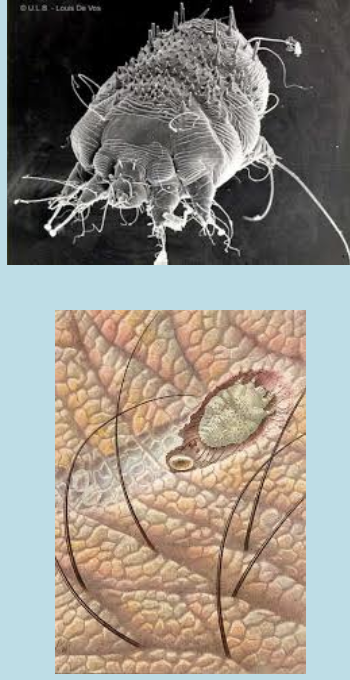
96
New cards
Sarcoptic Mange: How do I get it?
- Sarcoptic mange mites are highly contagious to humans and may be passed by close contact with infested animals, bedding, or grooming tools.
97
New cards
Sarcoptic Mange: What are the symptoms in animals?
Clinical signs include:
• Generalized hair loss
• Skin rash
• Crusting
• Skin infections may develop secondary to the intense irritation.
• Generalized hair loss
• Skin rash
• Crusting
• Skin infections may develop secondary to the intense irritation.
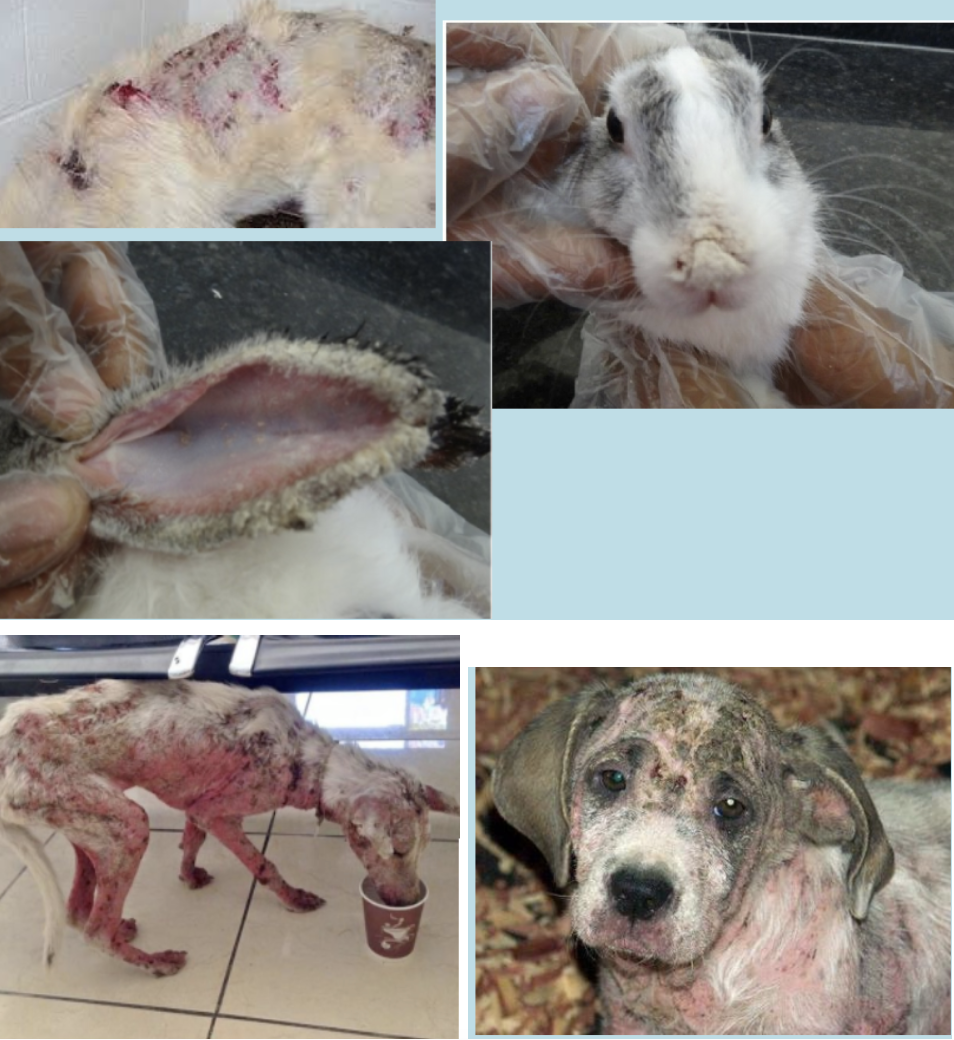
98
New cards
Sarcoptic Mange: Diagnosis, prevention and treatment
The lifecycle of the mite is 21 days
Protected by skin crusts
- Clean the lesion, spray, dip, pour-on, ointment, injection, clean the environment, REPEAT
Protected by skin crusts
- Clean the lesion, spray, dip, pour-on, ointment, injection, clean the environment, REPEAT
99
New cards
Sarcoptic Mange: What are the symptoms in humans?
Symptoms and signs of scabies include generalized intense itching; the condition is sometimes called the "seven year itch."
Symptoms and signs of scabies on the skin vary and may include short, linear, or nodular "burrows" between the fingers, tiny red bumps and blisters on the skin, or a widespread, crusted rash. Often, there are no visible skin lesions.
Symptoms and signs of scabies on the skin vary and may include short, linear, or nodular "burrows" between the fingers, tiny red bumps and blisters on the skin, or a widespread, crusted rash. Often, there are no visible skin lesions.

100
New cards
Toxoplasmosis: What is it?
- Toxoplasmosis is caused by a single-celled parasite called: Toxoplasma gondii.
- More than 30 million men, women, and children in the U.S. carry the Toxoplasma parasite, but very few have symptoms because the immune system usually keeps the parasite from causing illness
(CDC, 2017).
- More than 30 million men, women, and children in the U.S. carry the Toxoplasma parasite, but very few have symptoms because the immune system usually keeps the parasite from causing illness
(CDC, 2017).